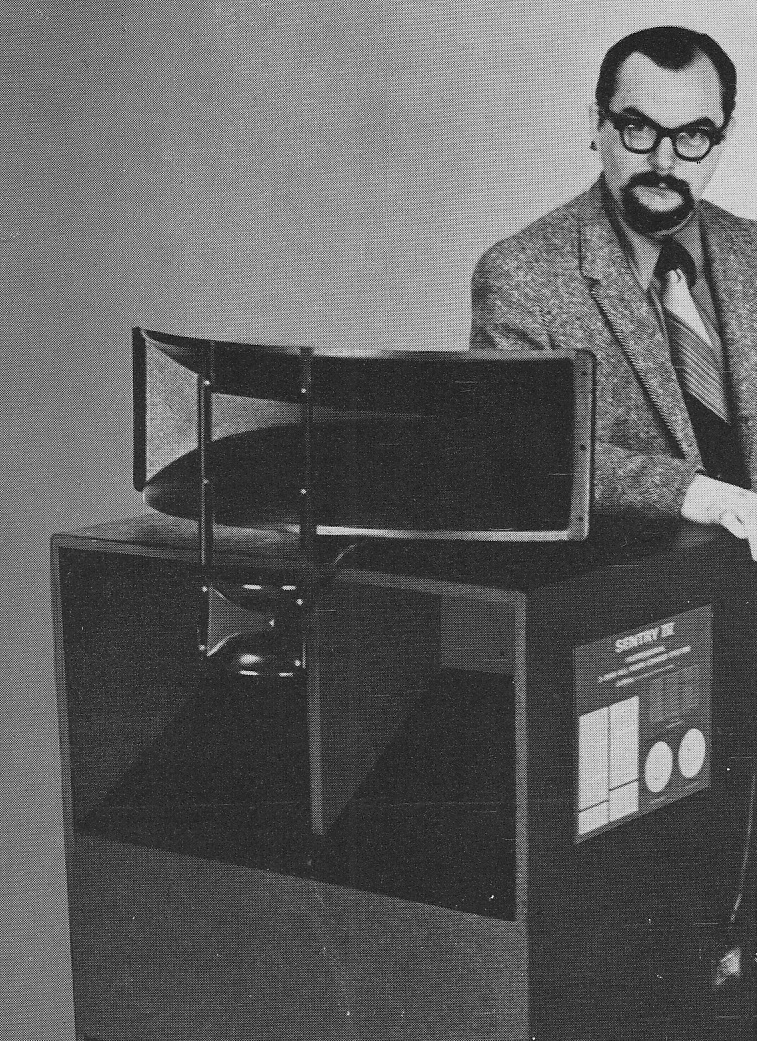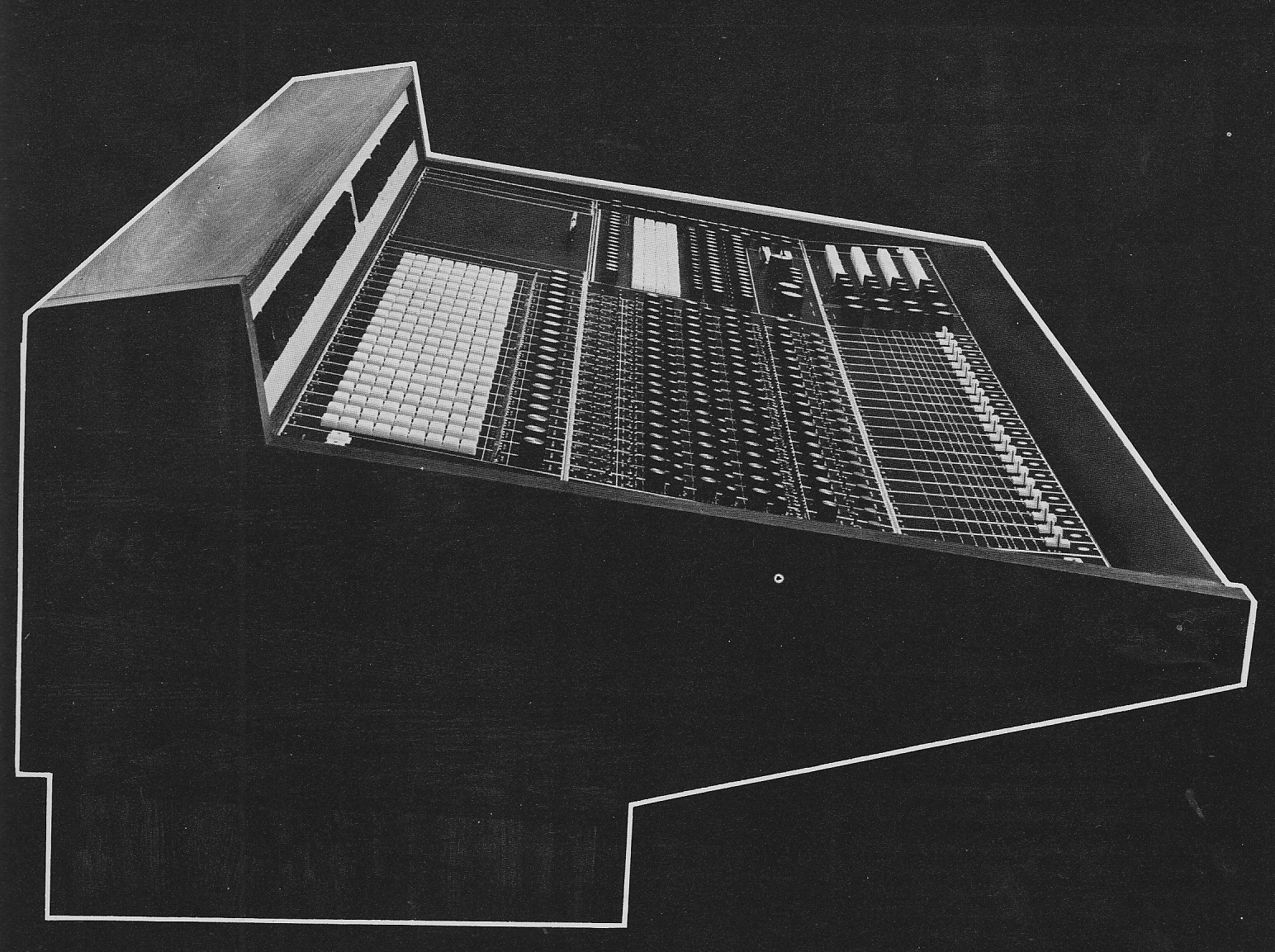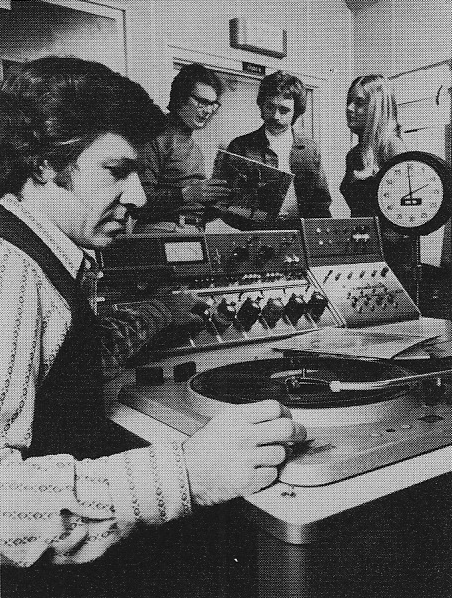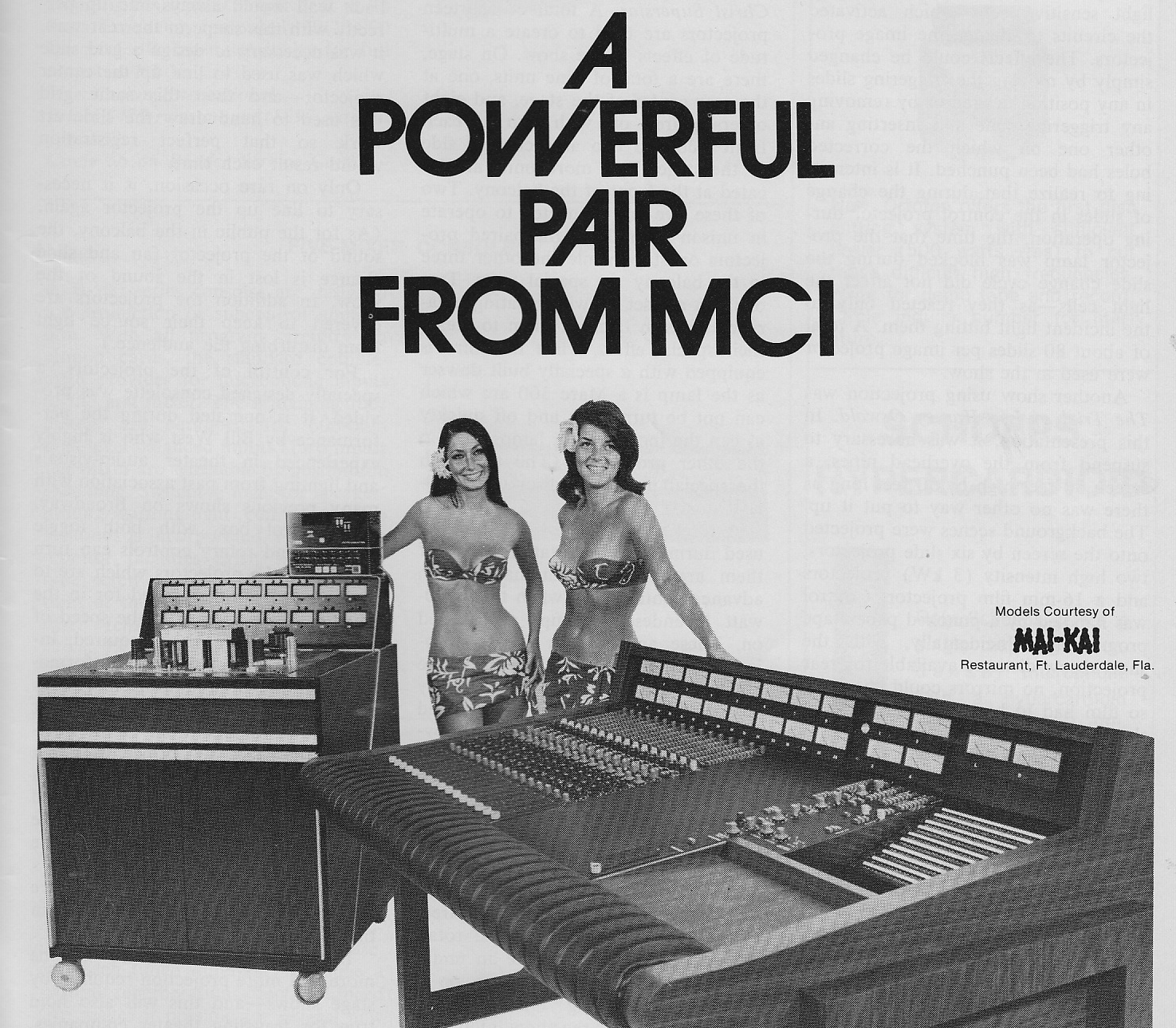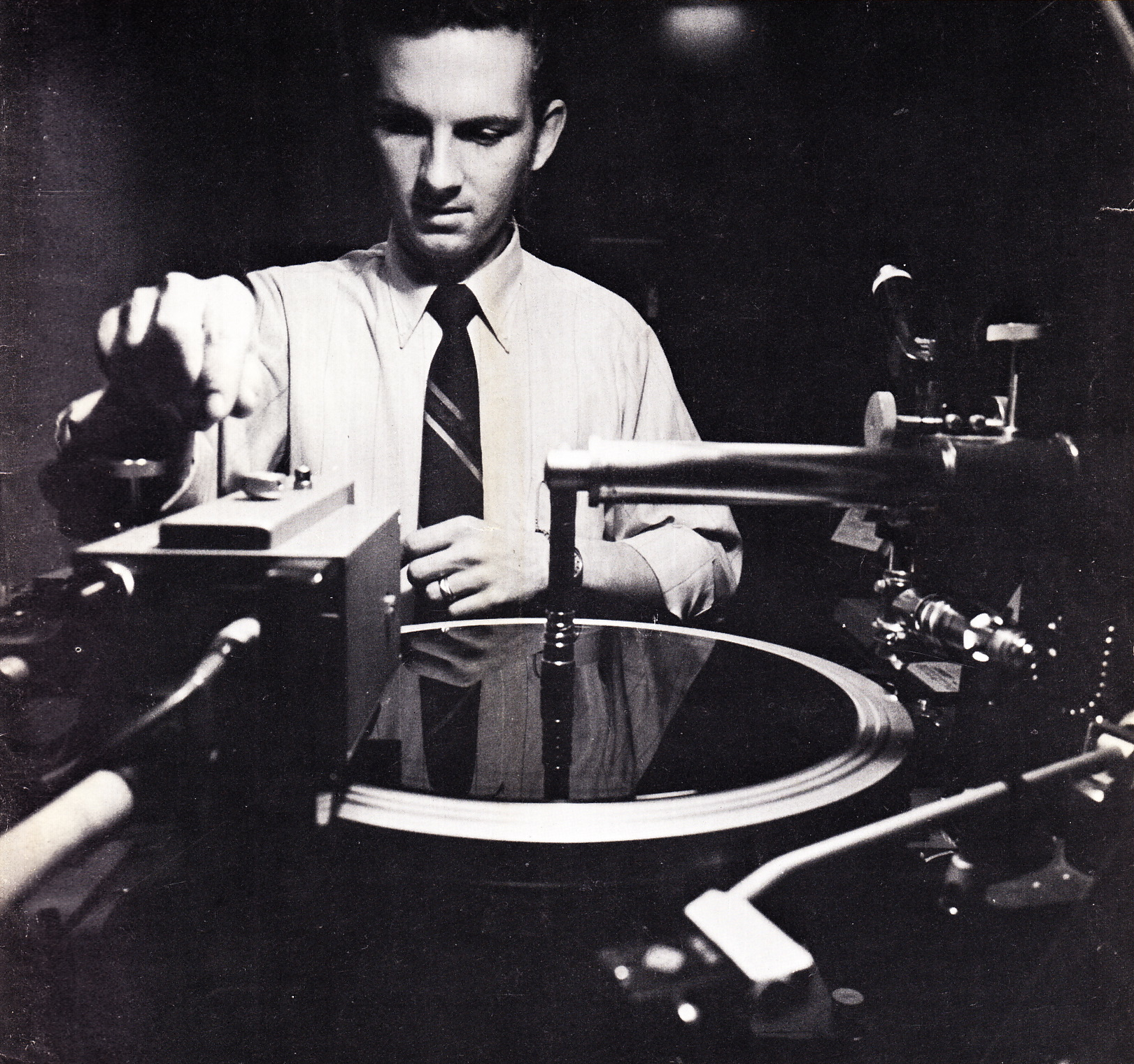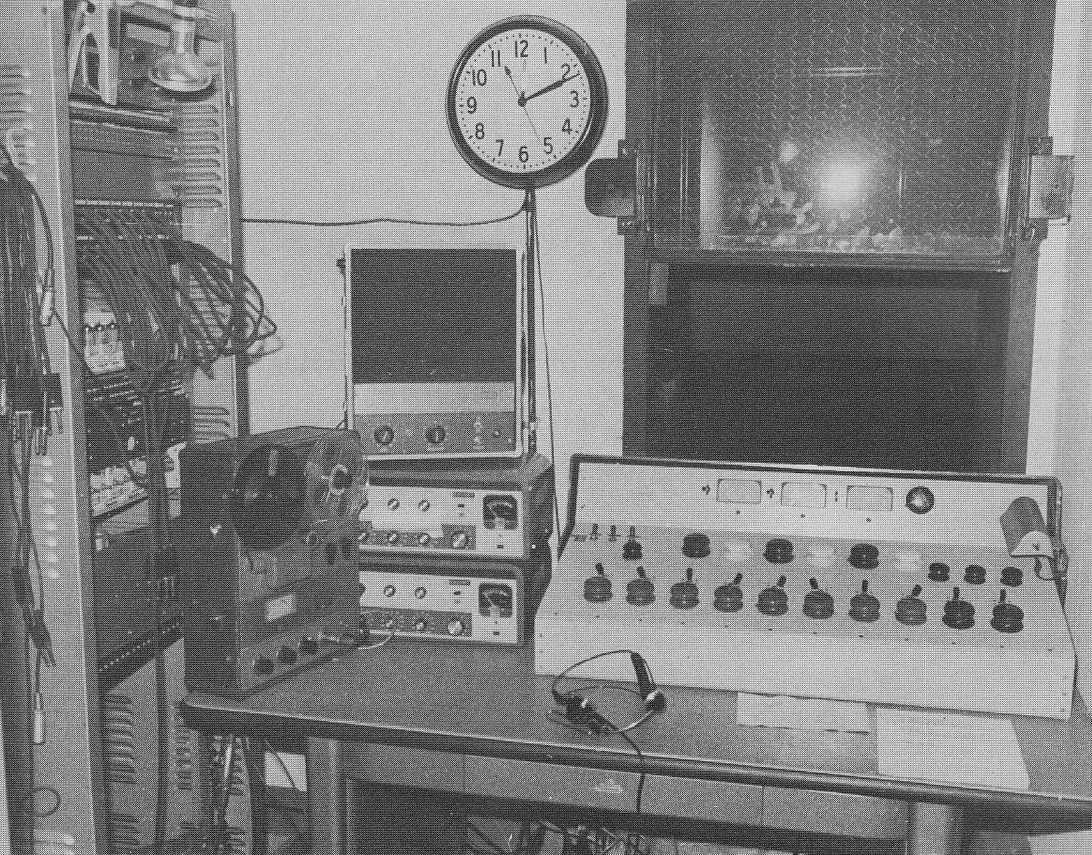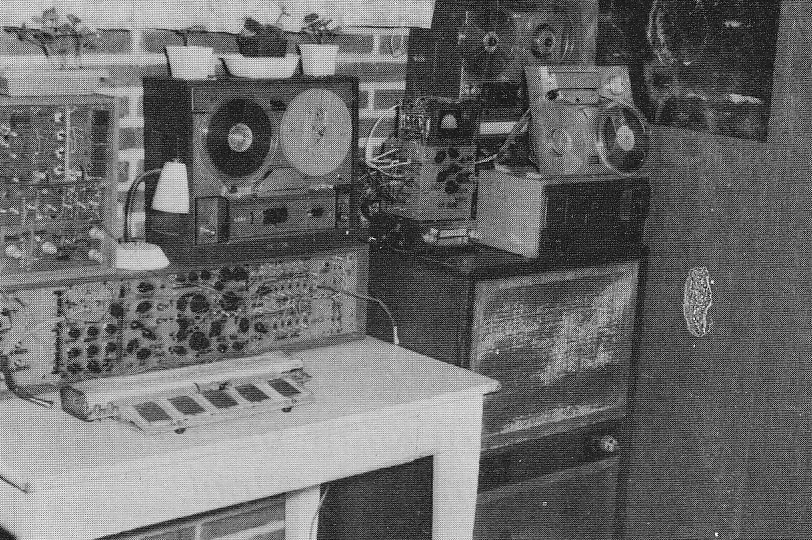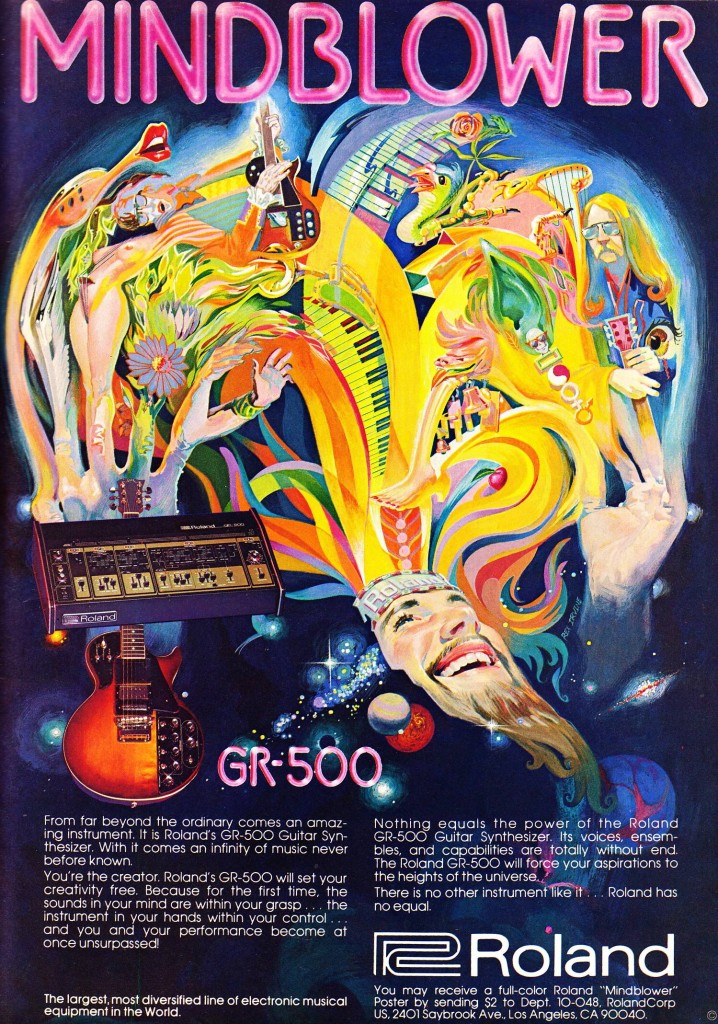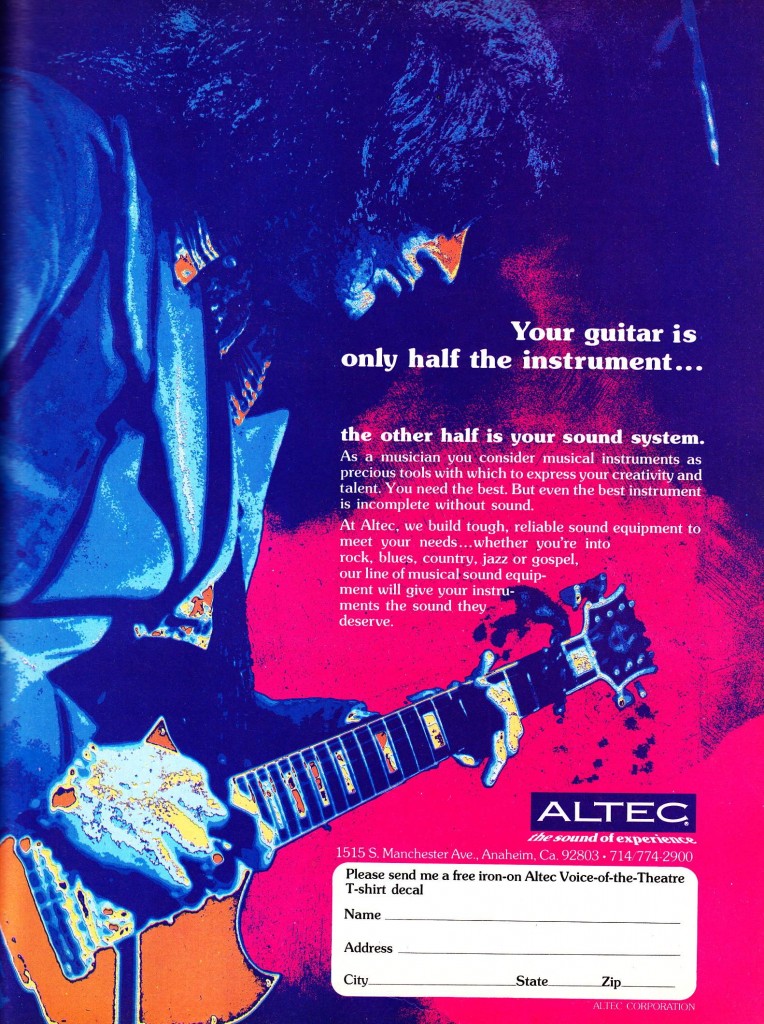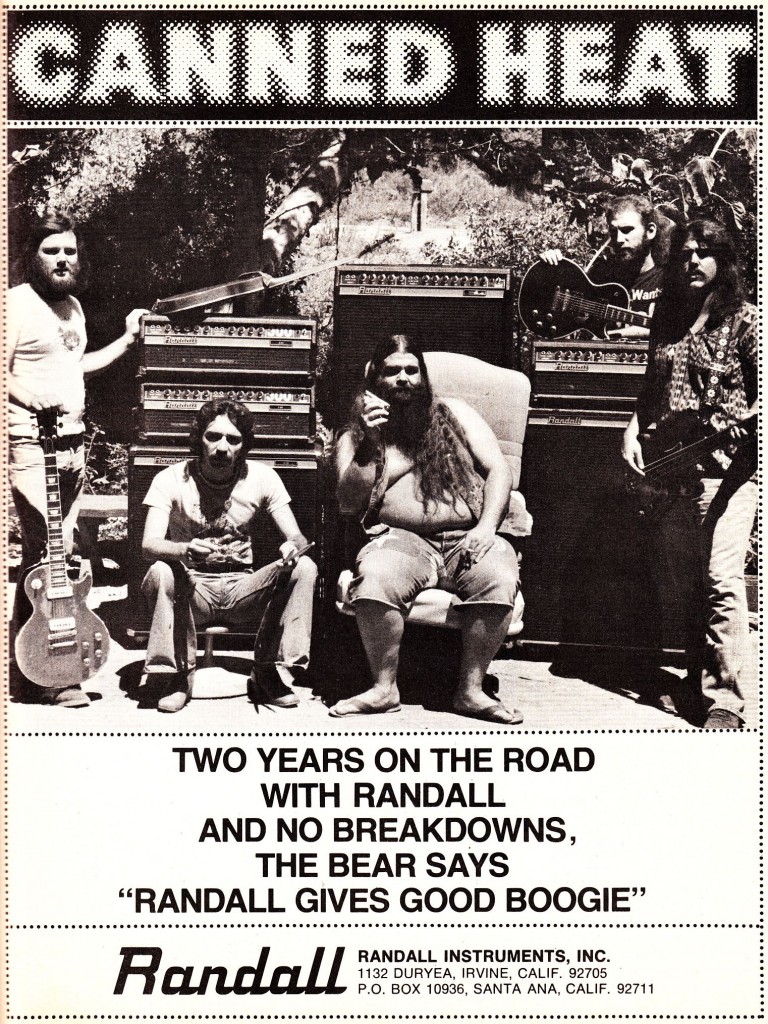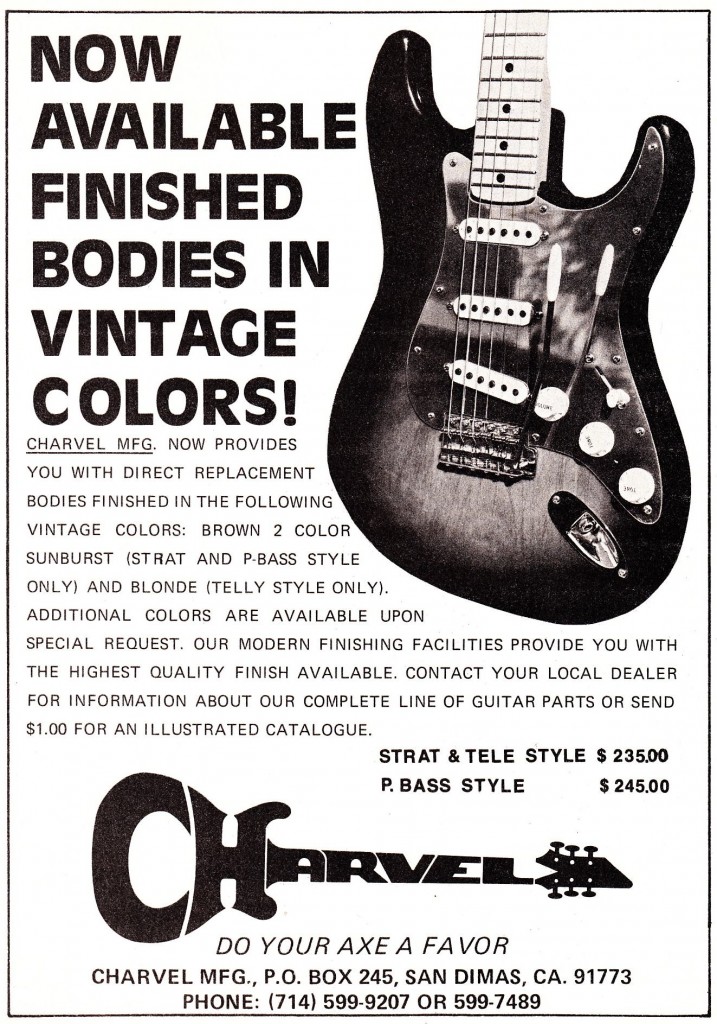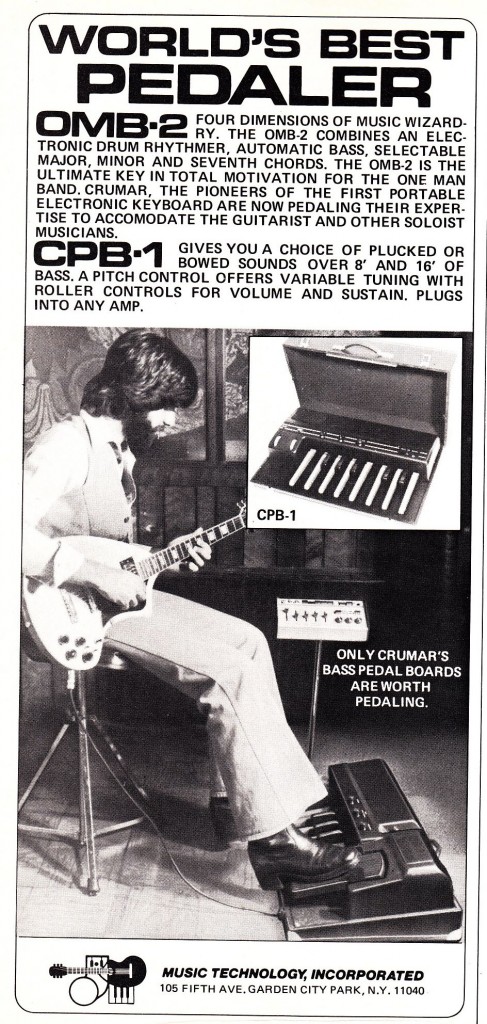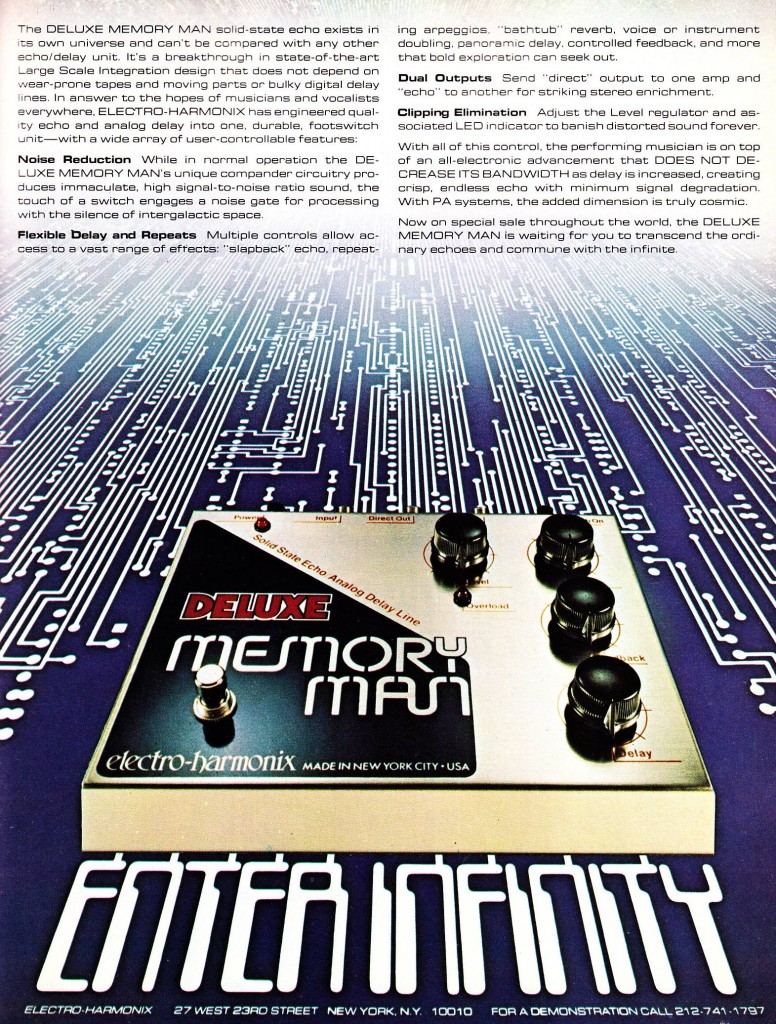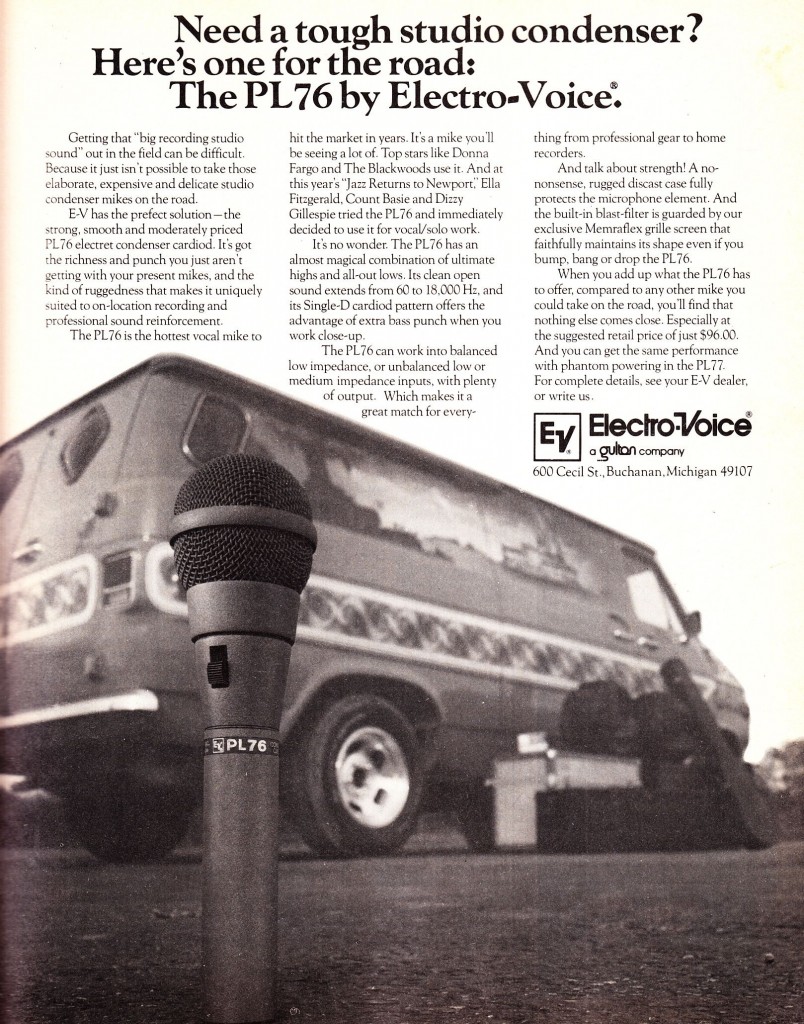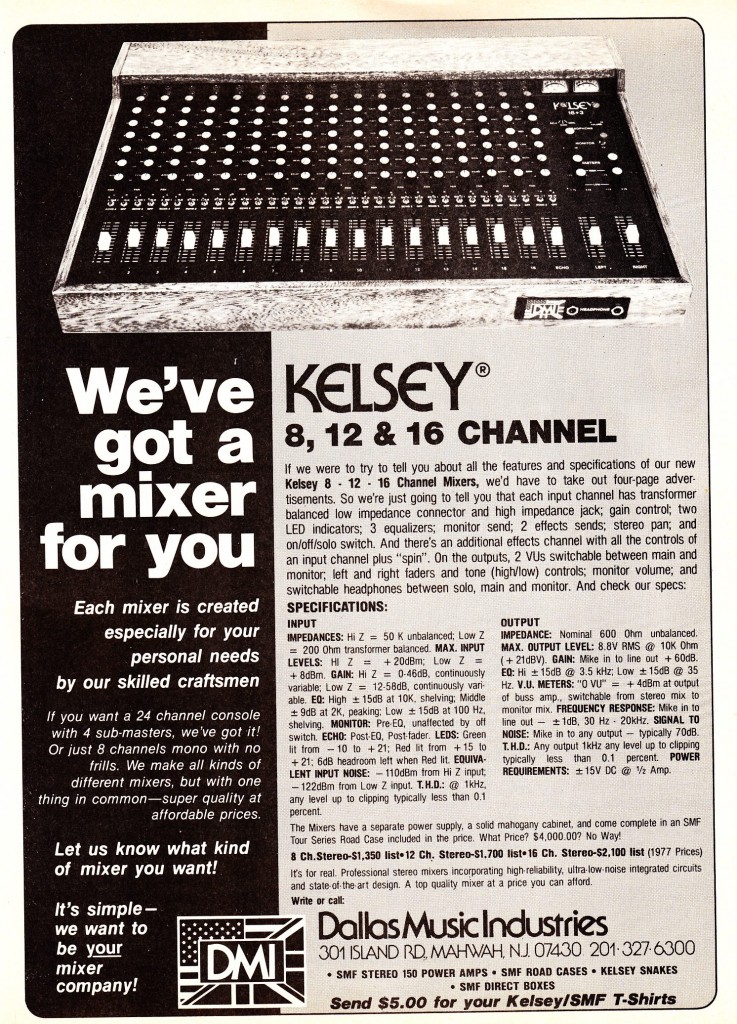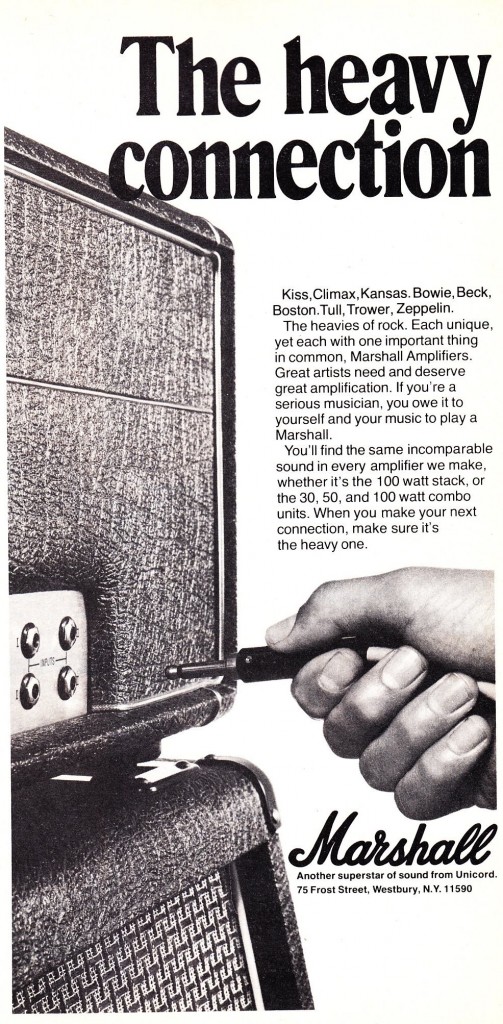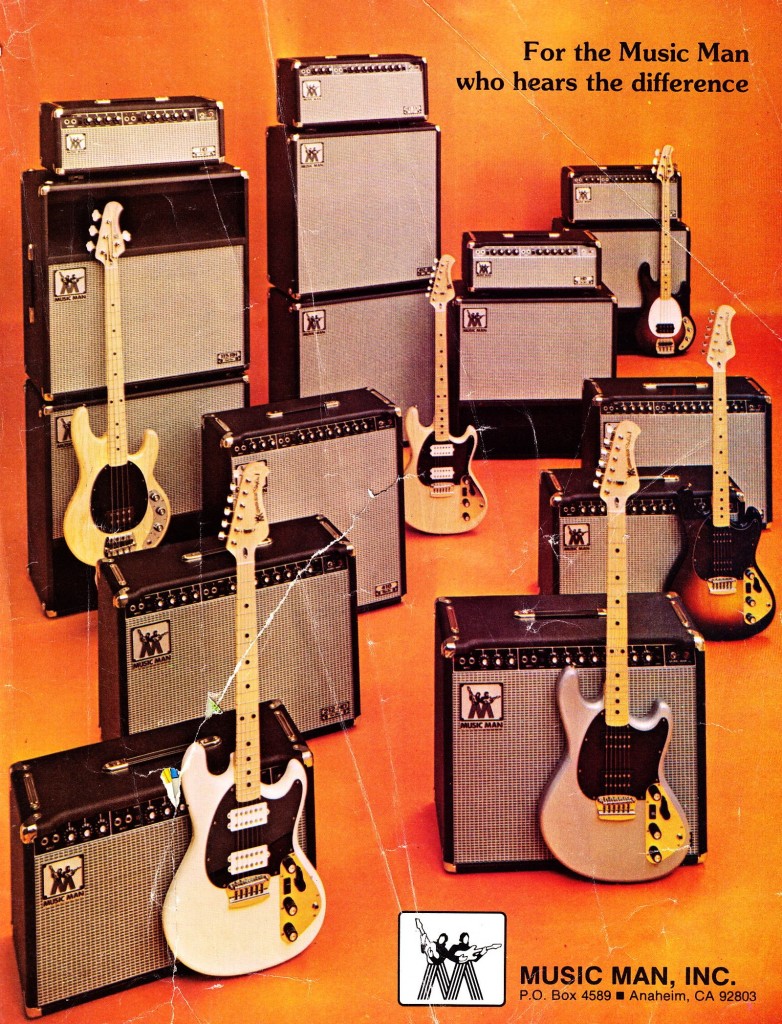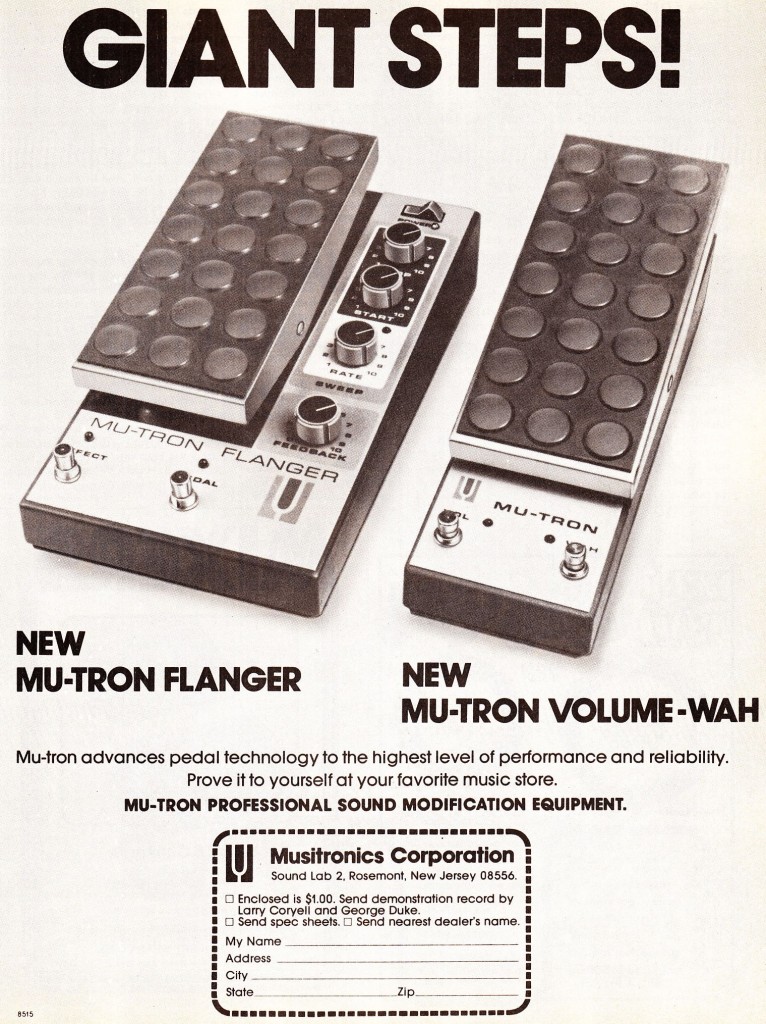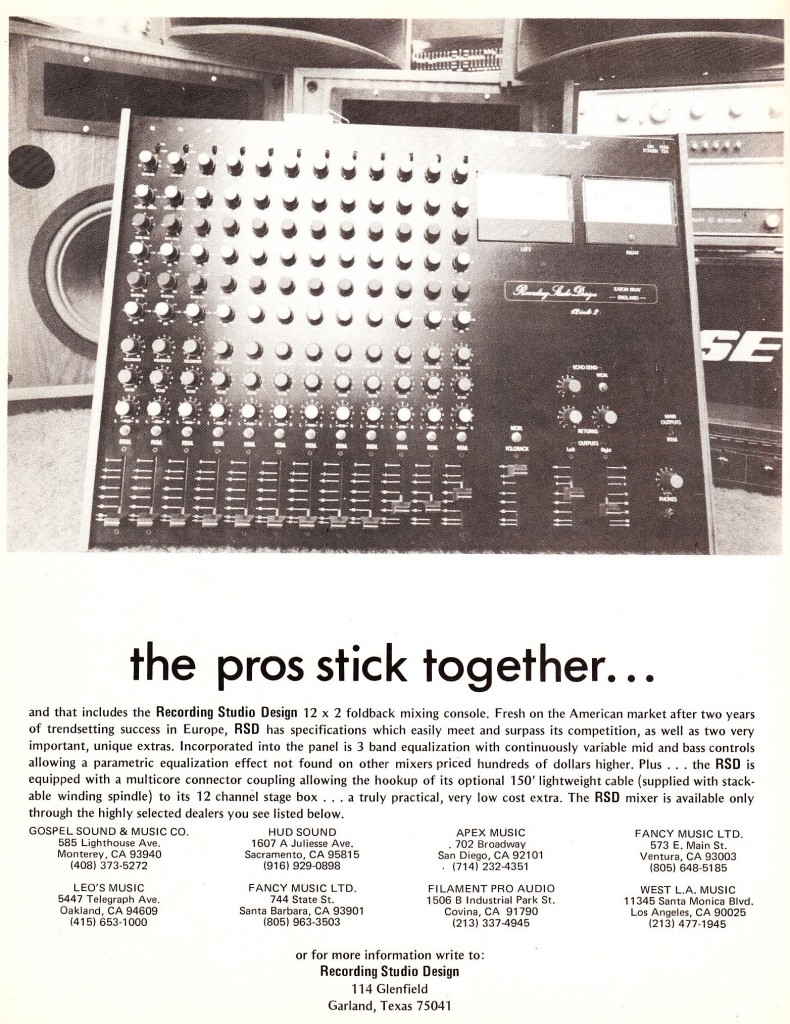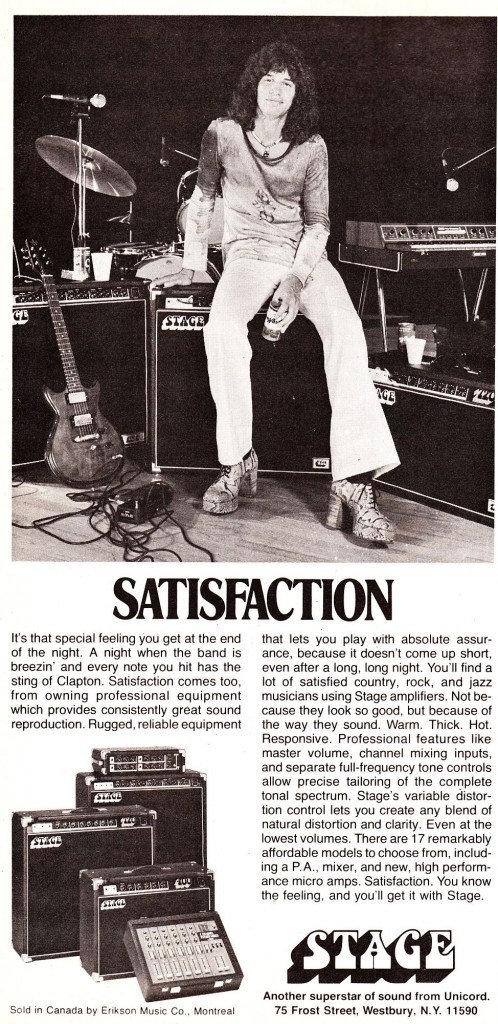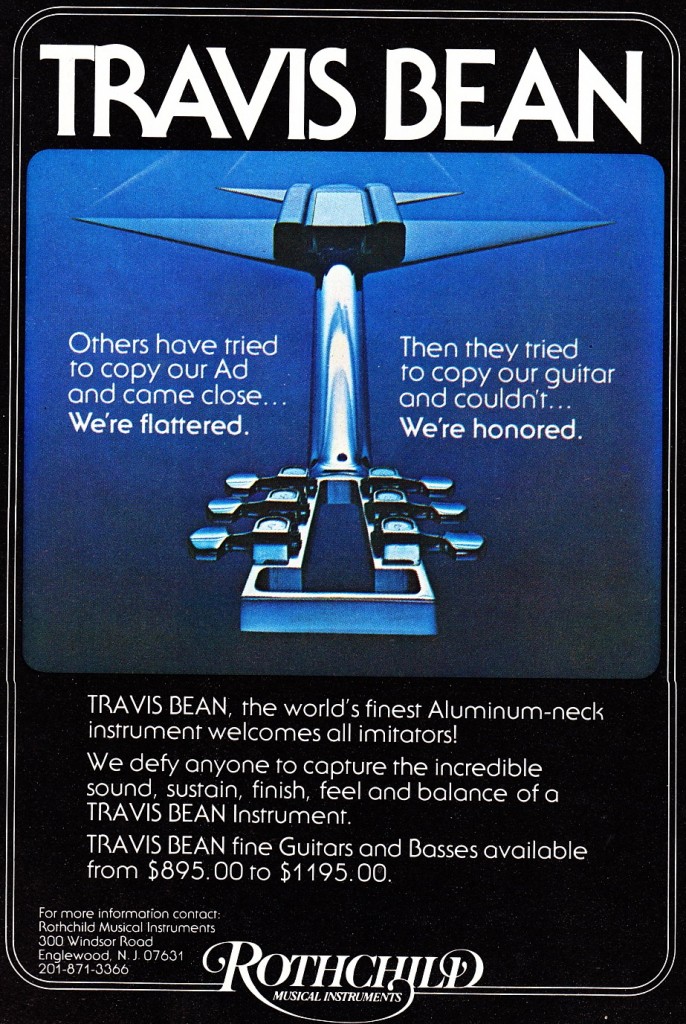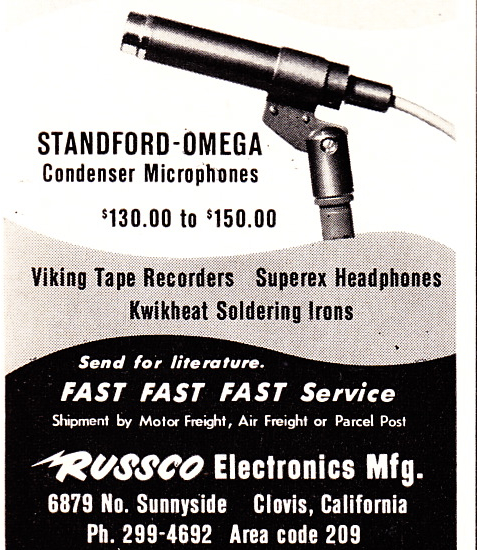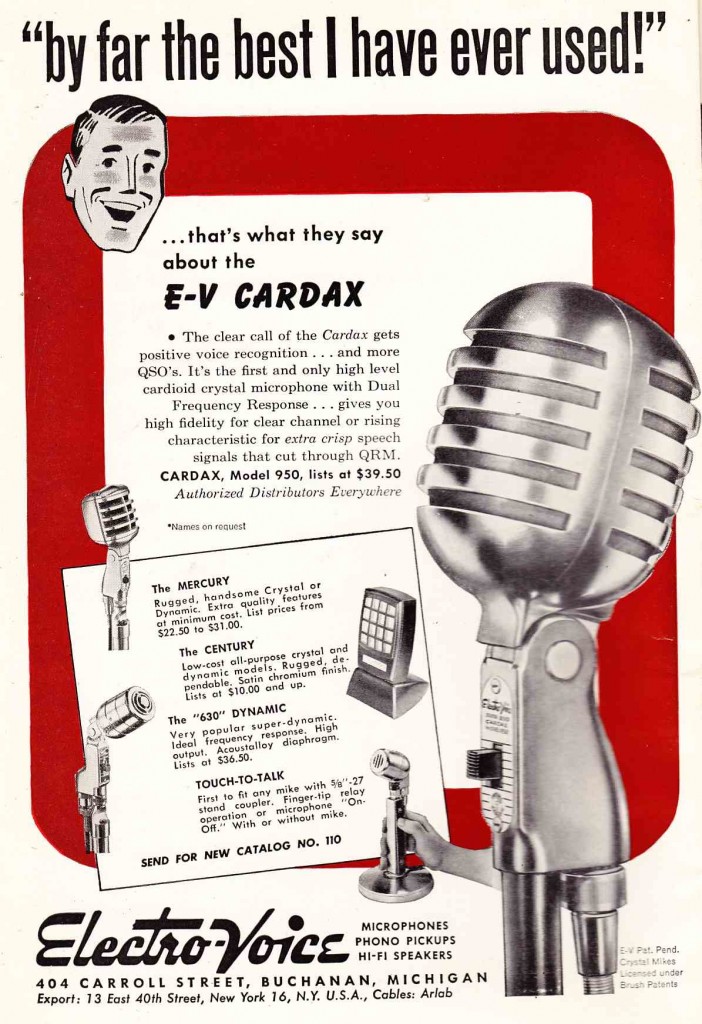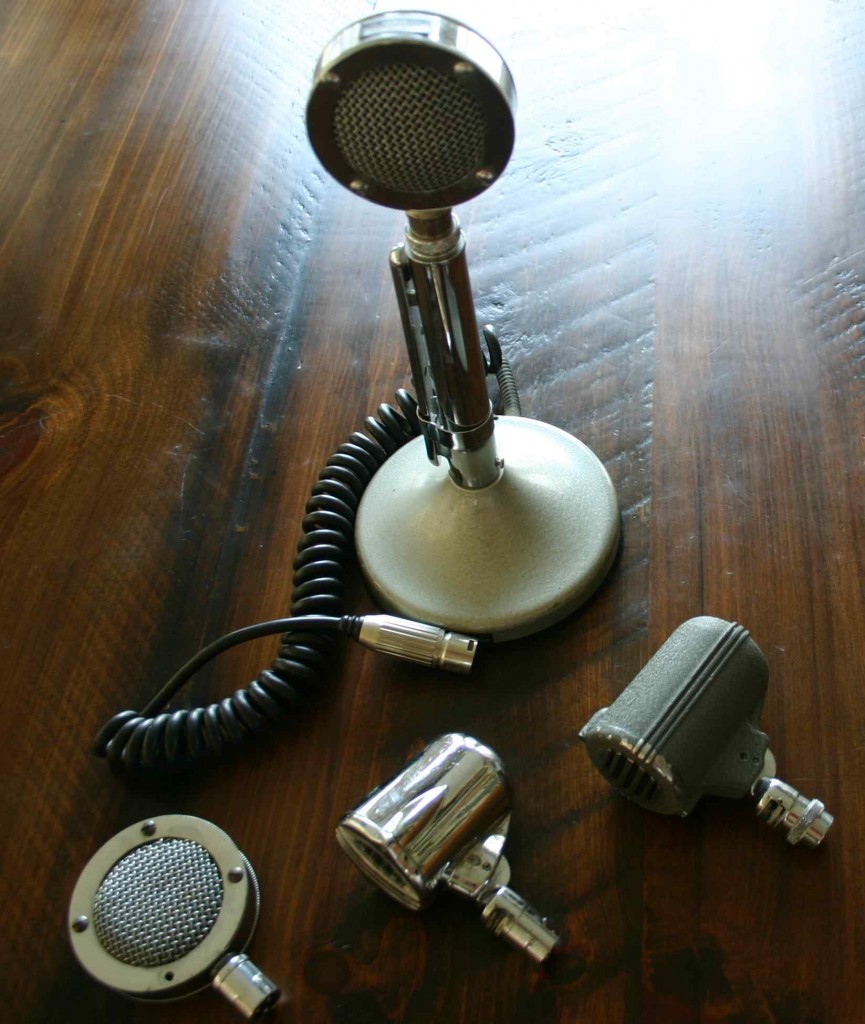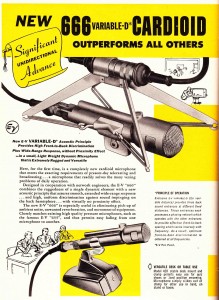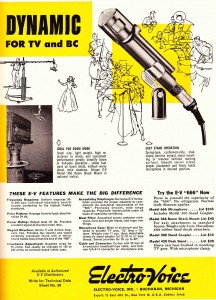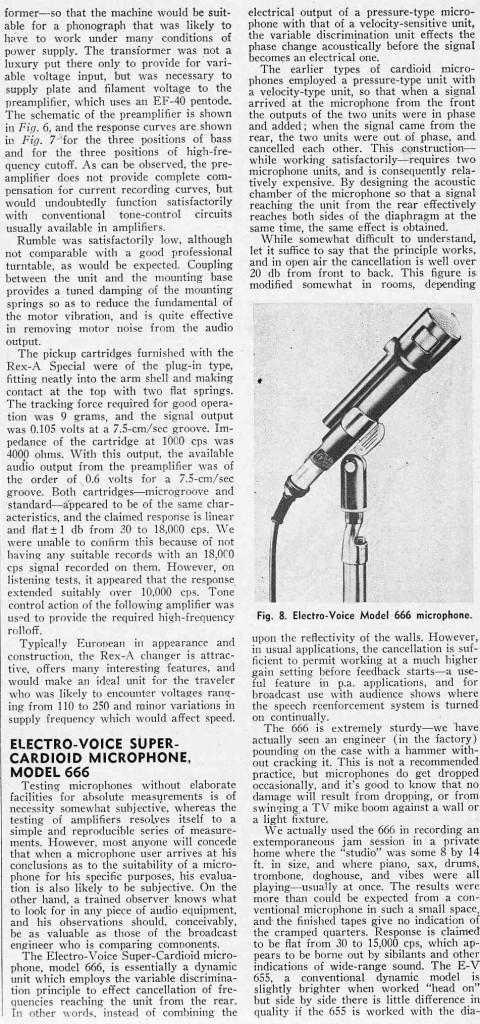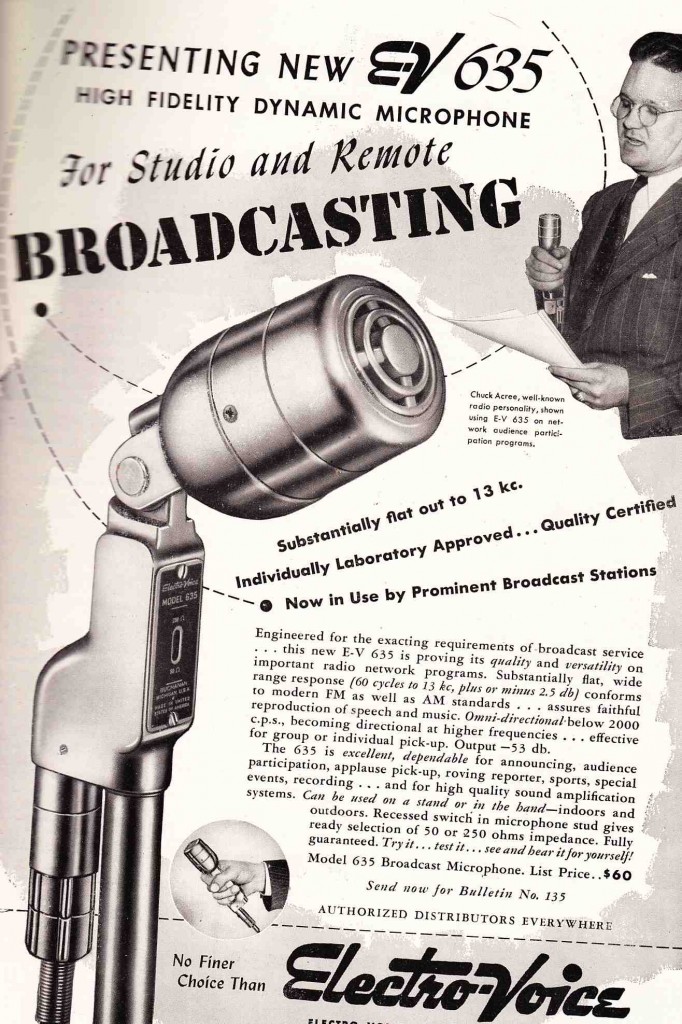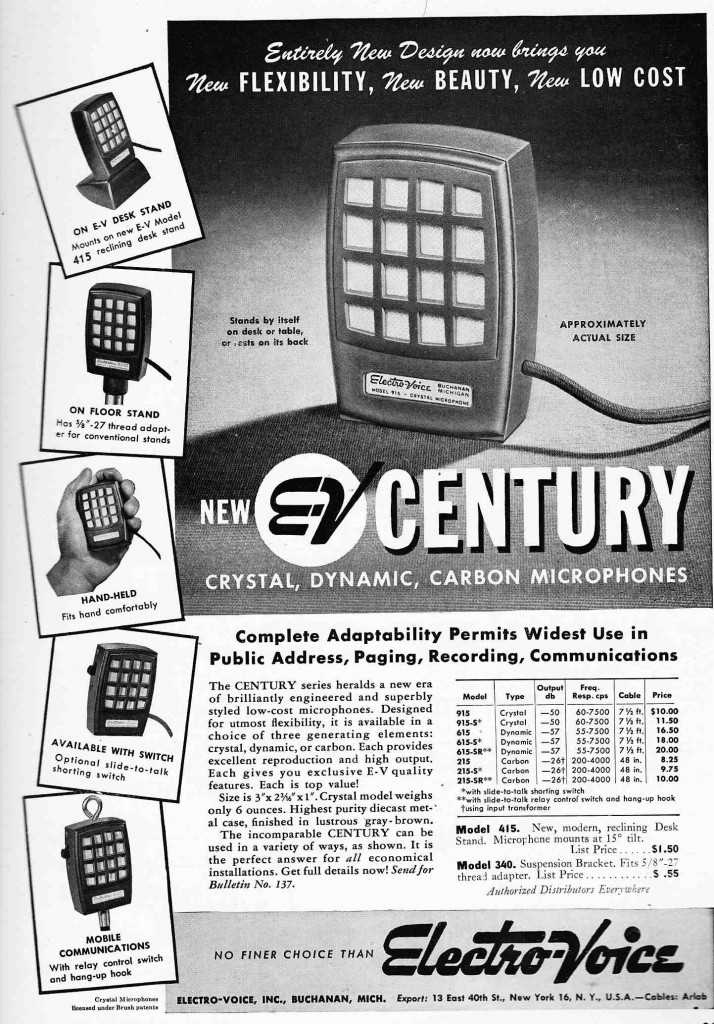Tag: electrovoice
1977
Today: a random display of offbeat bits from 1977 that caught my eye: a tiny homage to the wonder that is The Internet K Hole. IE., draw your own connections/conclusions.
Today: just a round-up of some broadcast mics that caught my eye for some or another reason: above, the ‘Stanford-Omega’ condenser mic. This is an odd one. Anyone?
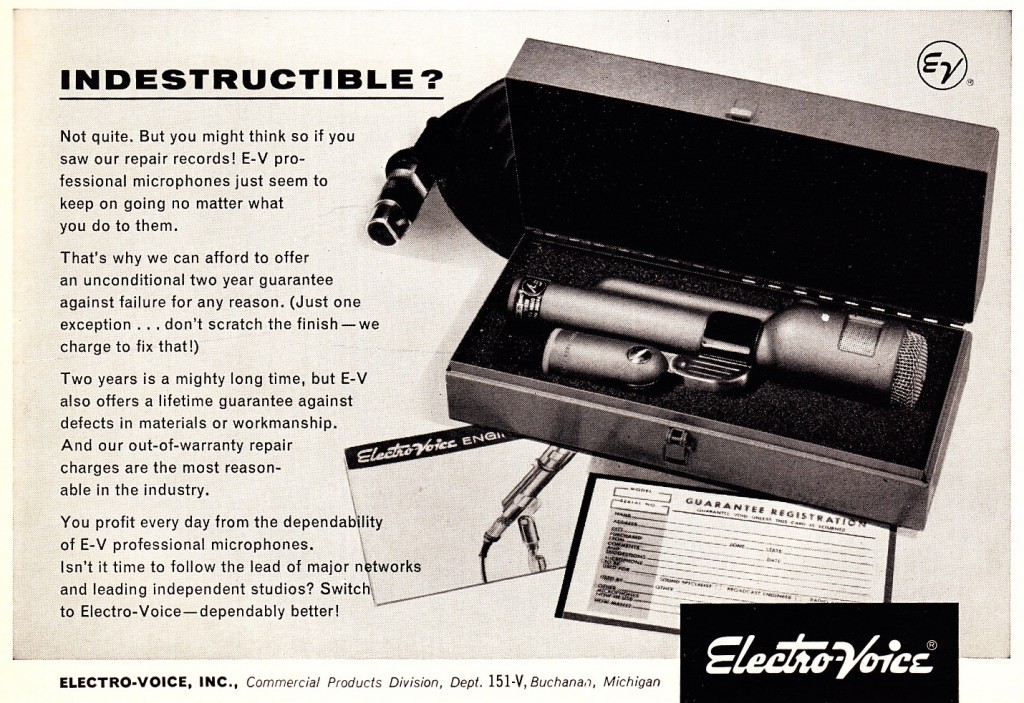 EV (electrovoice) 666. I think I have mentioned this one about a million times already: it’s the predecessor to the RE-20, a mic that I have used+ dig more than almost any other. EV 666’s appear in just a ton of great-sounding old TV music-broadcasts… Miles Davis on PBS comes to mind… I must have bid on these things on eBay about 20 times. No luck yet. Soon enough. Oh but BTW I finally did get an RE15 (and not cheap either…) and it is really, really underwhelming. Still my faith persists…
EV (electrovoice) 666. I think I have mentioned this one about a million times already: it’s the predecessor to the RE-20, a mic that I have used+ dig more than almost any other. EV 666’s appear in just a ton of great-sounding old TV music-broadcasts… Miles Davis on PBS comes to mind… I must have bid on these things on eBay about 20 times. No luck yet. Soon enough. Oh but BTW I finally did get an RE15 (and not cheap either…) and it is really, really underwhelming. Still my faith persists…
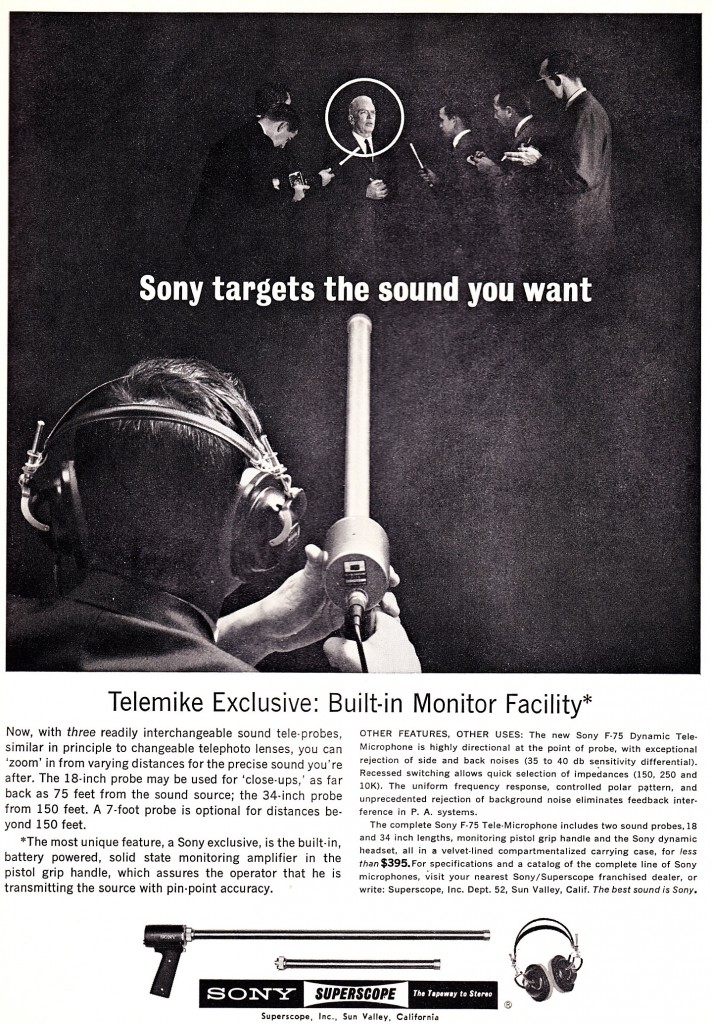 Sony TELEMIKE circa 1964, with an (up-to) seven-foot probe! And it comes with a built-in headphone amp. Wild…
Sony TELEMIKE circa 1964, with an (up-to) seven-foot probe! And it comes with a built-in headphone amp. Wild…
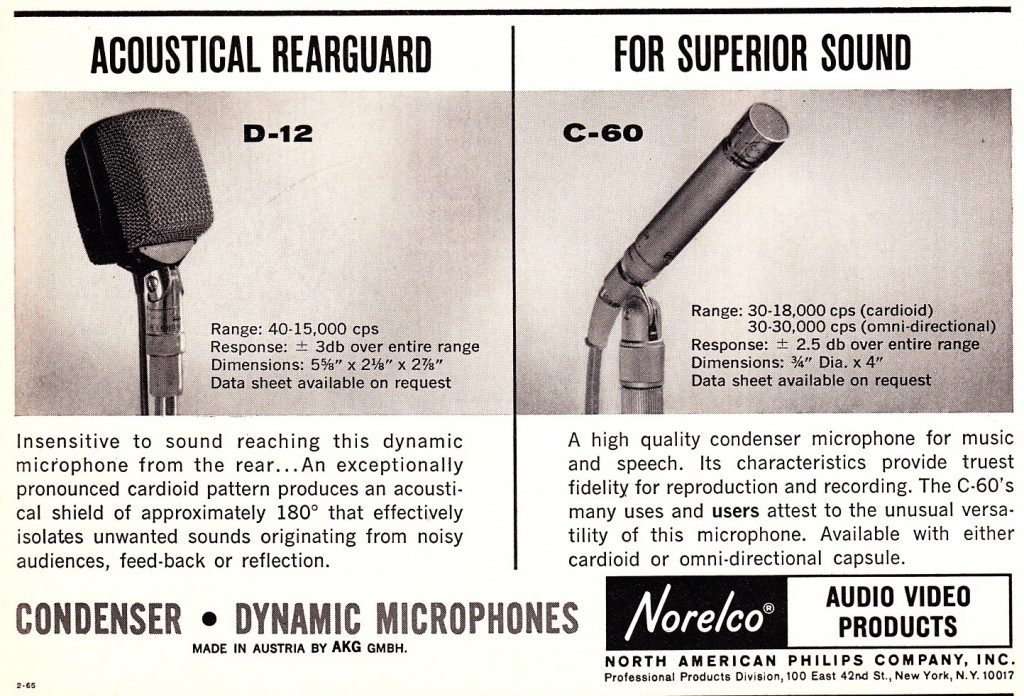 AKG D-12 and C-60 circa 1963, a few years before the D-12 became the industry-standard in kick-drum mic’ing. AKG recently sent me one of their new D-12 ‘VR’ models to review, and it’s pretty great, although not a re-issue in any strict sense… full review to come soon.
AKG D-12 and C-60 circa 1963, a few years before the D-12 became the industry-standard in kick-drum mic’ing. AKG recently sent me one of their new D-12 ‘VR’ models to review, and it’s pretty great, although not a re-issue in any strict sense… full review to come soon.
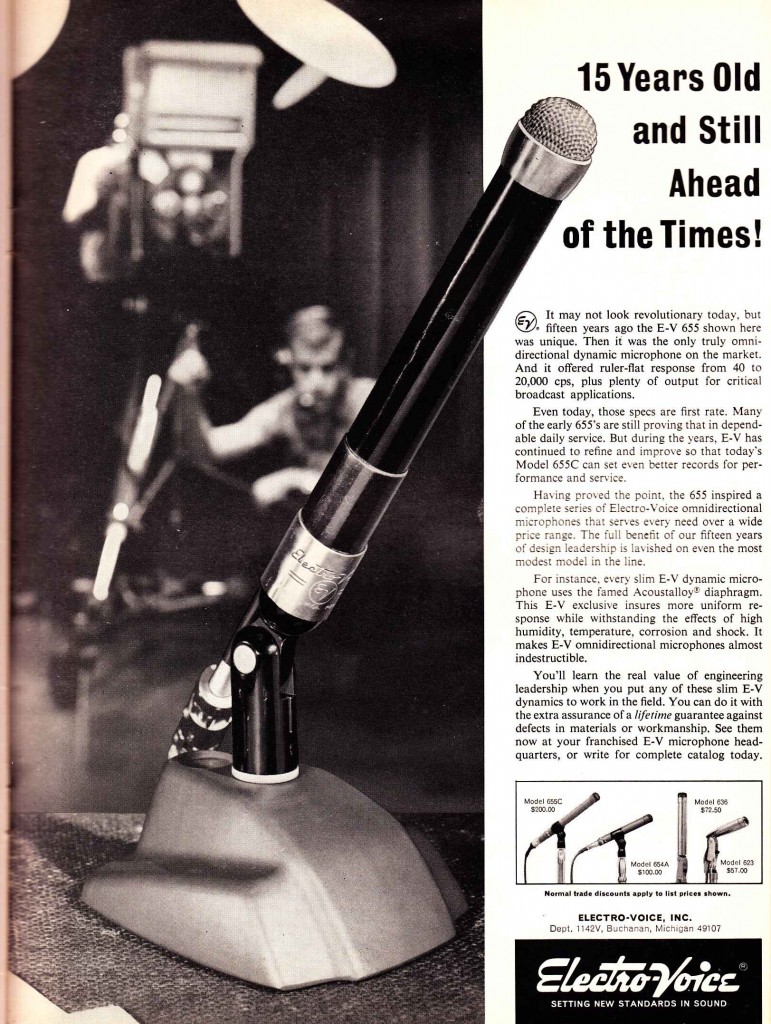 And finally the EV 655, another favorite of mine… just great sounding omni mics, pretty incredible fidelity for units that were introduced in 1951. Lots more on this site about them.
And finally the EV 655, another favorite of mine… just great sounding omni mics, pretty incredible fidelity for units that were introduced in 1951. Lots more on this site about them.
A Few Interesting Mics of the 70s
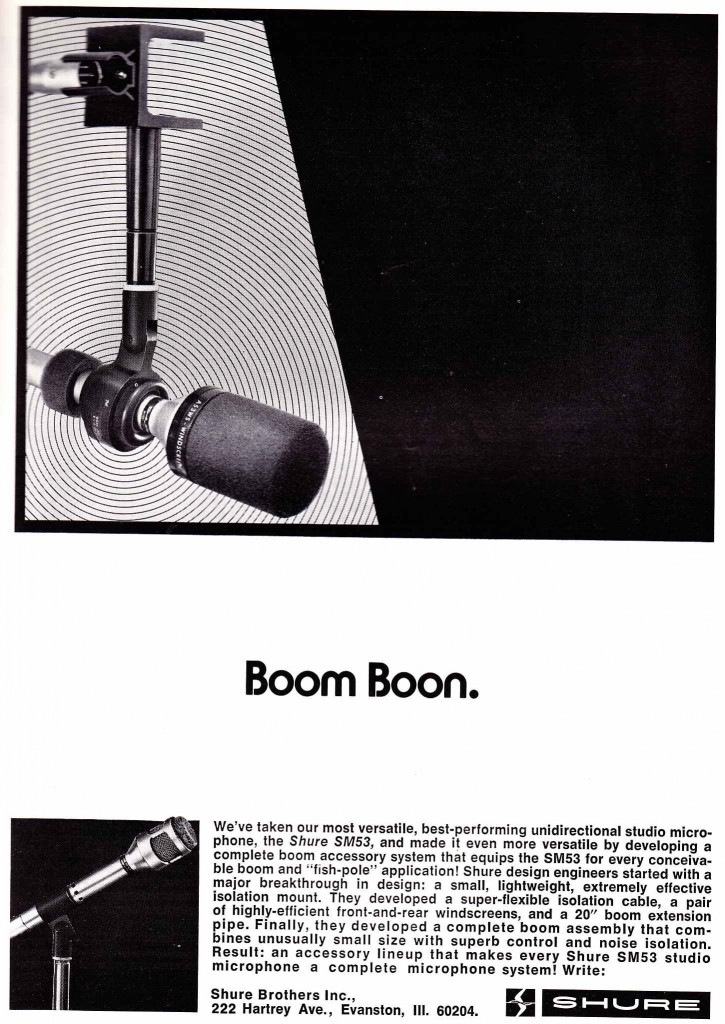 Today at PS dot com: 70’s month nears its close with a quick look at some promising but lesser-known mics of the 70s. If you are using any of these pieces in the studio these days, drop us a line and weigh in. above: the Shure SM53, a high-end dynamic cardiod that seems to maybe have been Shure’s answer to the RE15? I’ve been trying to pick one these up on eBay, no luck yet… anyone?
Today at PS dot com: 70’s month nears its close with a quick look at some promising but lesser-known mics of the 70s. If you are using any of these pieces in the studio these days, drop us a line and weigh in. above: the Shure SM53, a high-end dynamic cardiod that seems to maybe have been Shure’s answer to the RE15? I’ve been trying to pick one these up on eBay, no luck yet… anyone?
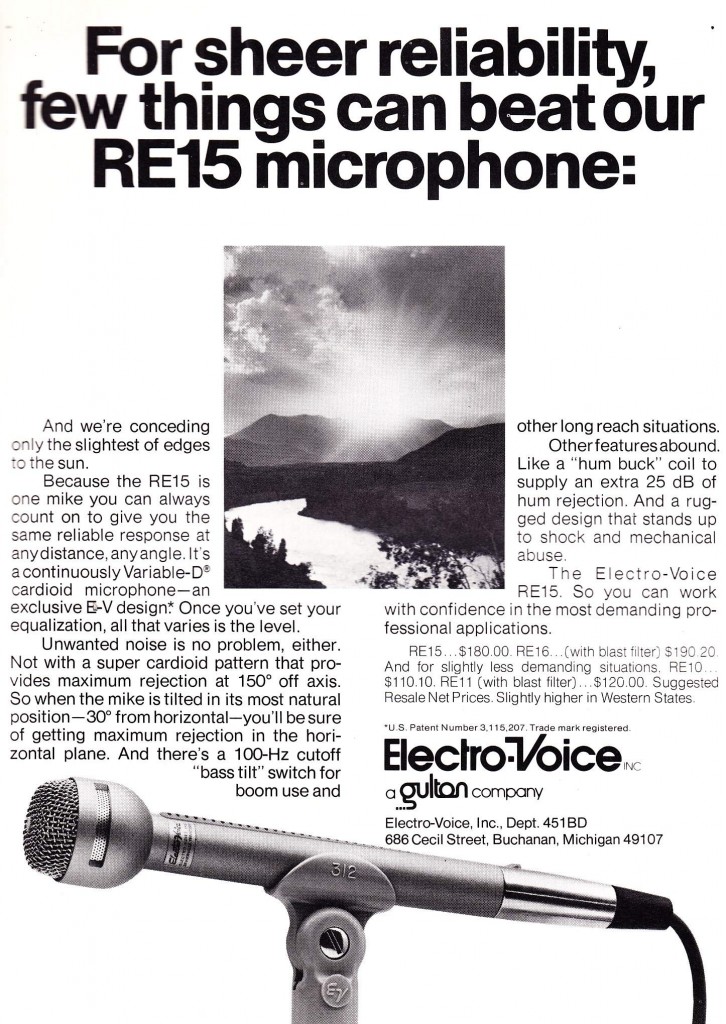 And speaking of the RE15… after watching the prices slowly rise on eBay for the past year, I finally picked up one of these.. expect some audio clips/shoot-out here soon. I always ignored these in the past, i figured, I have an RE20, what’s the point… but I finally had to know. I recently worked with a contractor/tech from a major live-sound company who had 1/2 the stage mic’d with these things, swears by ’em… anyway, I am super-curious. They are apparently very hi-fi with very accurate off-axis response. More to come…
And speaking of the RE15… after watching the prices slowly rise on eBay for the past year, I finally picked up one of these.. expect some audio clips/shoot-out here soon. I always ignored these in the past, i figured, I have an RE20, what’s the point… but I finally had to know. I recently worked with a contractor/tech from a major live-sound company who had 1/2 the stage mic’d with these things, swears by ’em… anyway, I am super-curious. They are apparently very hi-fi with very accurate off-axis response. More to come…
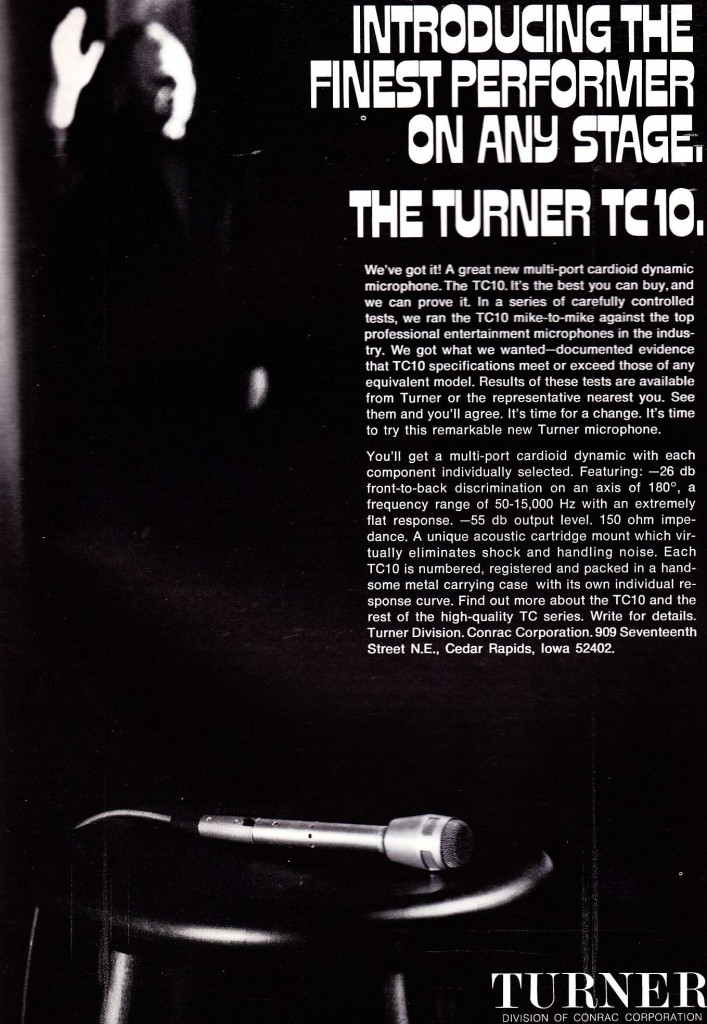 While on the subject of dynamic mics… above, the Turner Model 10 circa 1972. Those of you who’ve been following PS for a while will know that I am a big fan of obscure Turner models, especially the flagship models like the 510… I recently bought my second 510 for Gold Coast Recorders and I have to sadly report that it is not as awesome as the example I have had for years… Anyway, the Model 10 seems to have been a replacement for the 500/510 series… there is a super-rare Model 11 (likely the ‘selected’ hi-fi version of the Model 10) on eBay right now for really cheap… might be a good purchase for anyone looking for more interesting dynmics mics…
While on the subject of dynamic mics… above, the Turner Model 10 circa 1972. Those of you who’ve been following PS for a while will know that I am a big fan of obscure Turner models, especially the flagship models like the 510… I recently bought my second 510 for Gold Coast Recorders and I have to sadly report that it is not as awesome as the example I have had for years… Anyway, the Model 10 seems to have been a replacement for the 500/510 series… there is a super-rare Model 11 (likely the ‘selected’ hi-fi version of the Model 10) on eBay right now for really cheap… might be a good purchase for anyone looking for more interesting dynmics mics…
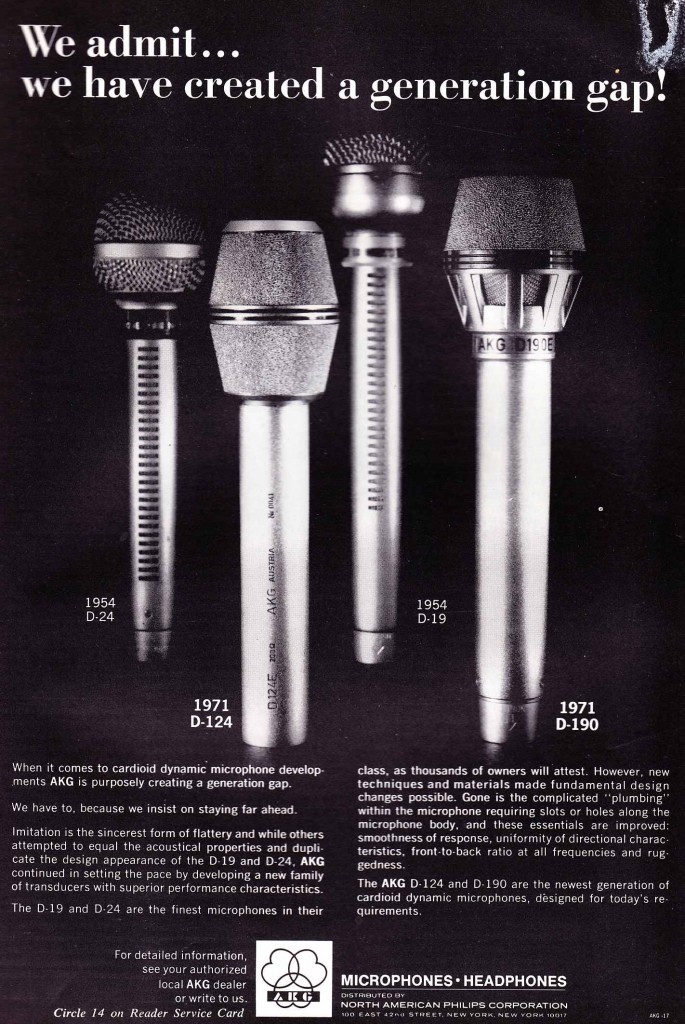 Above, the AKG D190 and D124! Finally some info on the D124… these turn up in my old 70s AKG catalogs (most of which you can download here on PS dot com), and I actually use this as the console talkback mic at GCR, but I had not realized that it was the replacement for the D-24. The D-124 is an amazing little piece of engineering, very nice smooth sound and incredibly small in size. D-190s are much more common, I tend to see these on CRList quite often.
Above, the AKG D190 and D124! Finally some info on the D124… these turn up in my old 70s AKG catalogs (most of which you can download here on PS dot com), and I actually use this as the console talkback mic at GCR, but I had not realized that it was the replacement for the D-24. The D-124 is an amazing little piece of engineering, very nice smooth sound and incredibly small in size. D-190s are much more common, I tend to see these on CRList quite often.
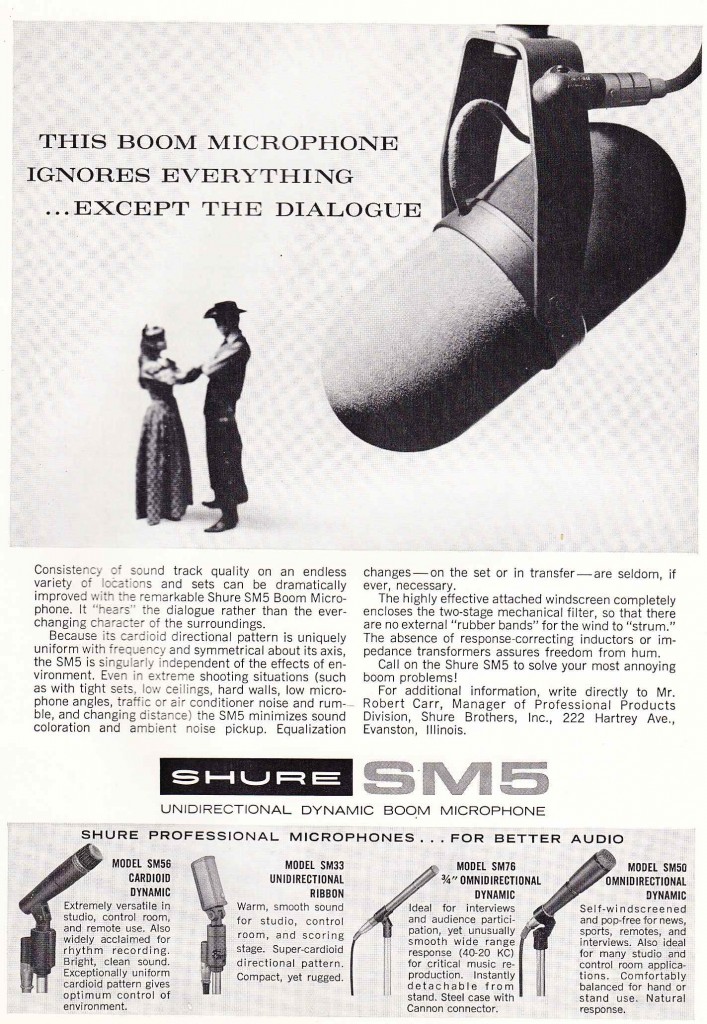 Above: Shure SM5 circa 1969. I love the similar SM7, use it regularly, it seems to have become somewhat of a standard-bearer vocal mic these days… artists actually ask for it in the studio the same way some will ask for an 87 or 47 or 58…. The SM5 is much less common, no longer made, and consequently extremely expensive. Are any of y’all using SM5s for music or vocal recording these days? Thoughts?
Above: Shure SM5 circa 1969. I love the similar SM7, use it regularly, it seems to have become somewhat of a standard-bearer vocal mic these days… artists actually ask for it in the studio the same way some will ask for an 87 or 47 or 58…. The SM5 is much less common, no longer made, and consequently extremely expensive. Are any of y’all using SM5s for music or vocal recording these days? Thoughts?
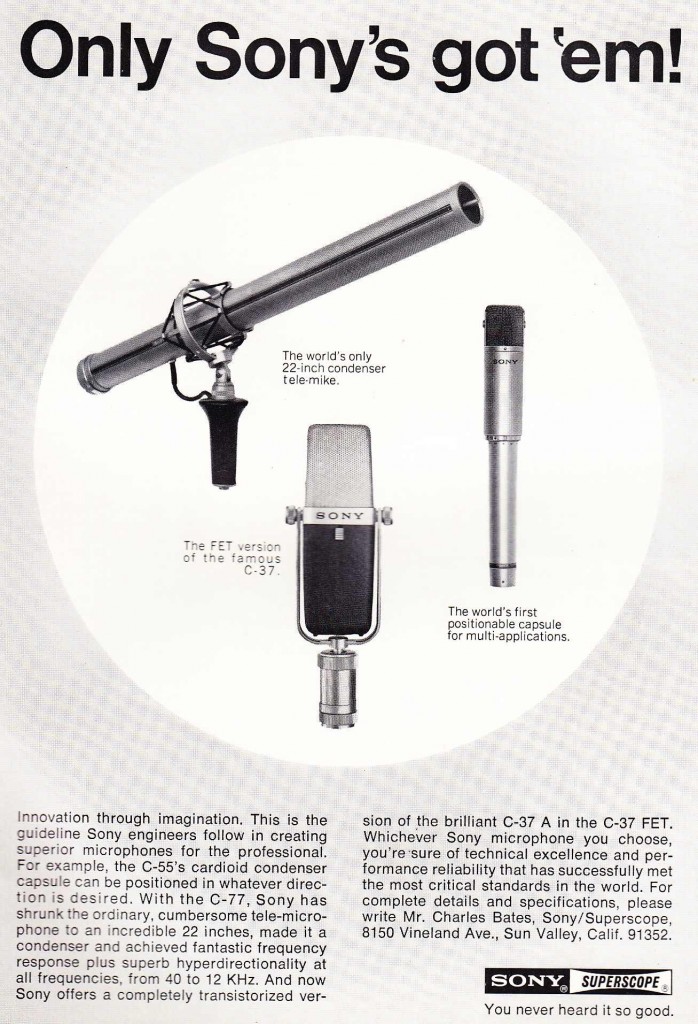 Above: Sony ‘Superscope’ branded C-77, C-37, and C-55 circa 1969. A C-37 or C-37 Fet is very high on my wish-list… Never used any of these models.. anyone?
Above: Sony ‘Superscope’ branded C-77, C-37, and C-55 circa 1969. A C-37 or C-37 Fet is very high on my wish-list… Never used any of these models.. anyone?
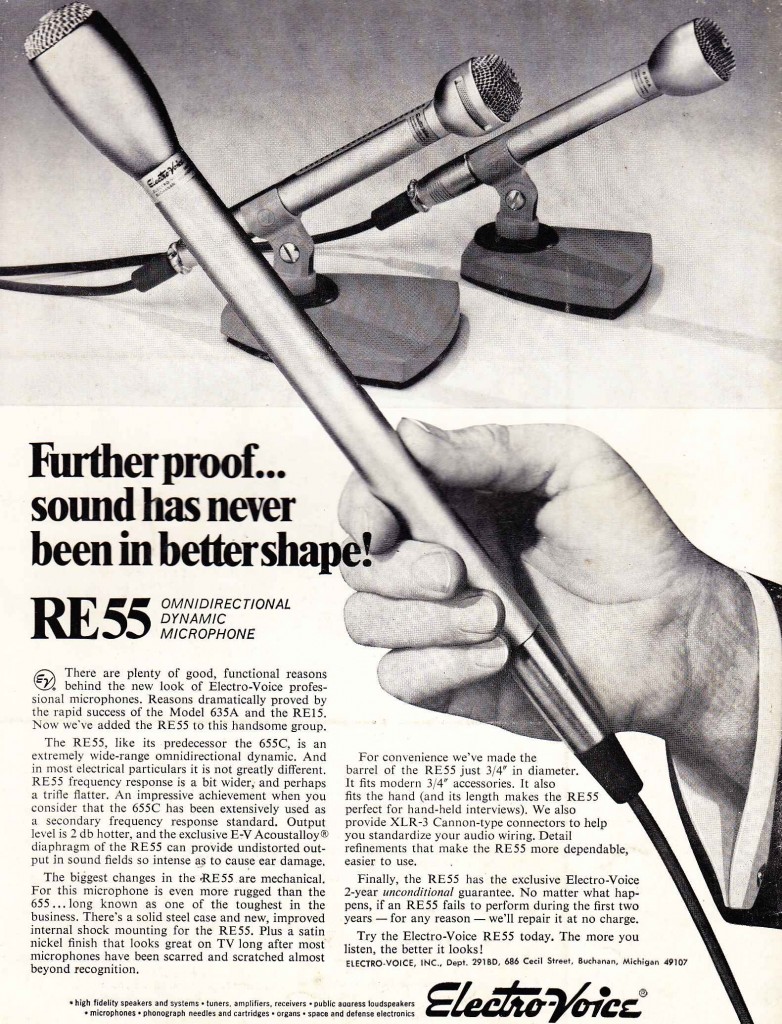 Above: the Electrovoice RE55 is introduced (1969). Interesting to see that the RE55 was the successor to the 655. I have a pair of 655 at GCR, very very old pair circa 1950, and wow they sound great. Fairly high self-noise for a dynamic, but for drum overheads it’s never a problem. Anyone using the RE55? Seem pretty uncommon…
Above: the Electrovoice RE55 is introduced (1969). Interesting to see that the RE55 was the successor to the 655. I have a pair of 655 at GCR, very very old pair circa 1950, and wow they sound great. Fairly high self-noise for a dynamic, but for drum overheads it’s never a problem. Anyone using the RE55? Seem pretty uncommon…
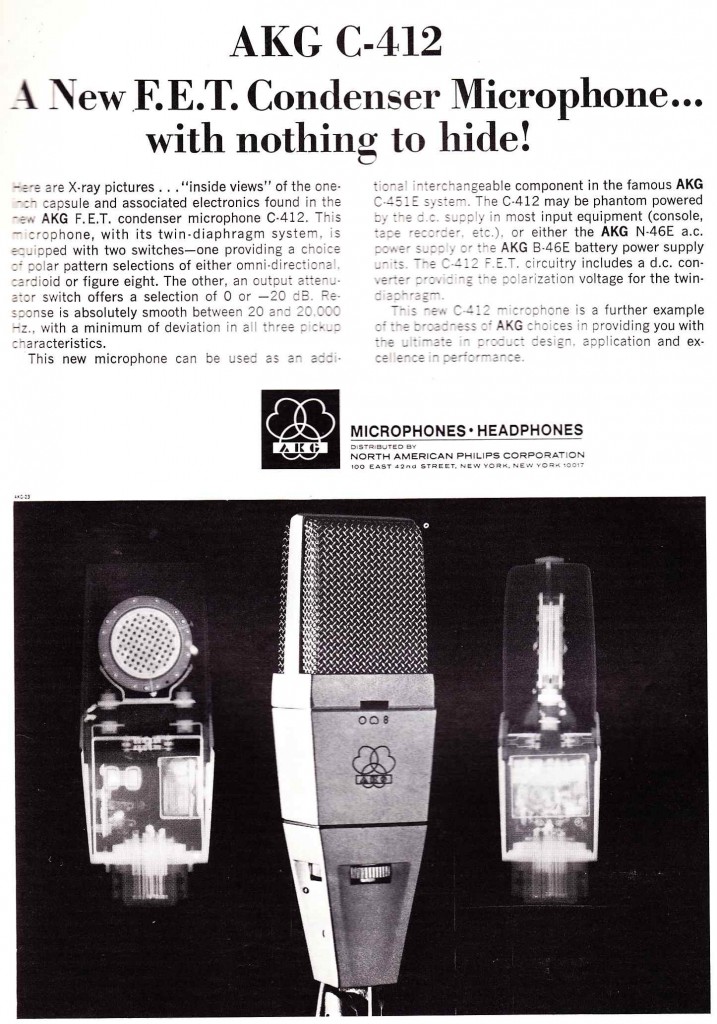 Above: The AKG 412 circa 1972. Seems to be the final evolution of the C12 prior to introduction of the still-standard 414. Anyone using a 412? Is it significantly different than a circa 70s 414?
Above: The AKG 412 circa 1972. Seems to be the final evolution of the C12 prior to introduction of the still-standard 414. Anyone using a 412? Is it significantly different than a circa 70s 414?
A Seven-Foot-Long Microphone
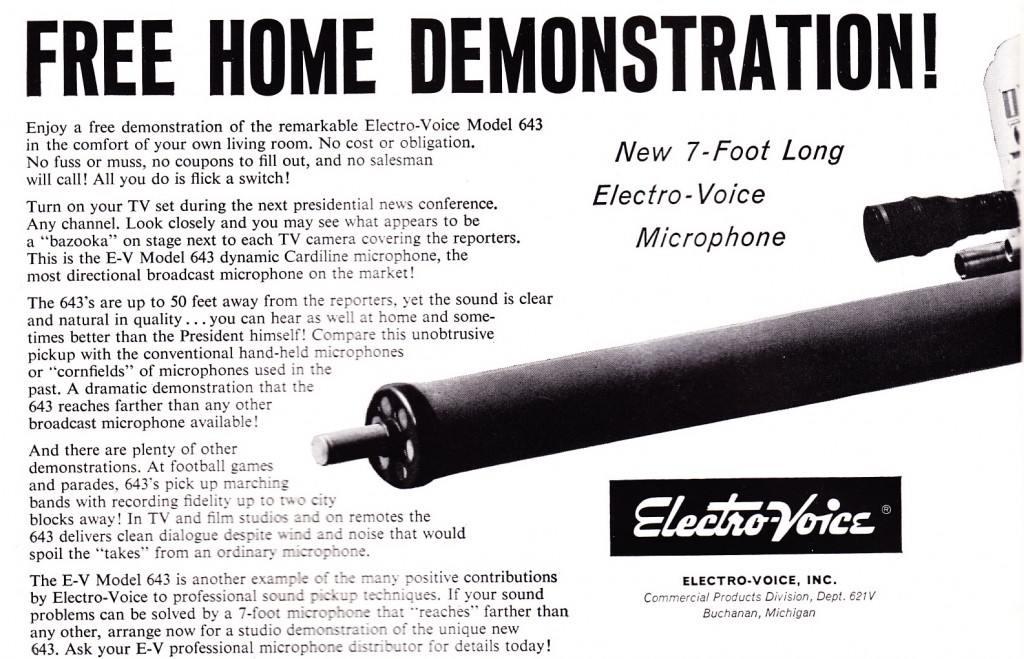
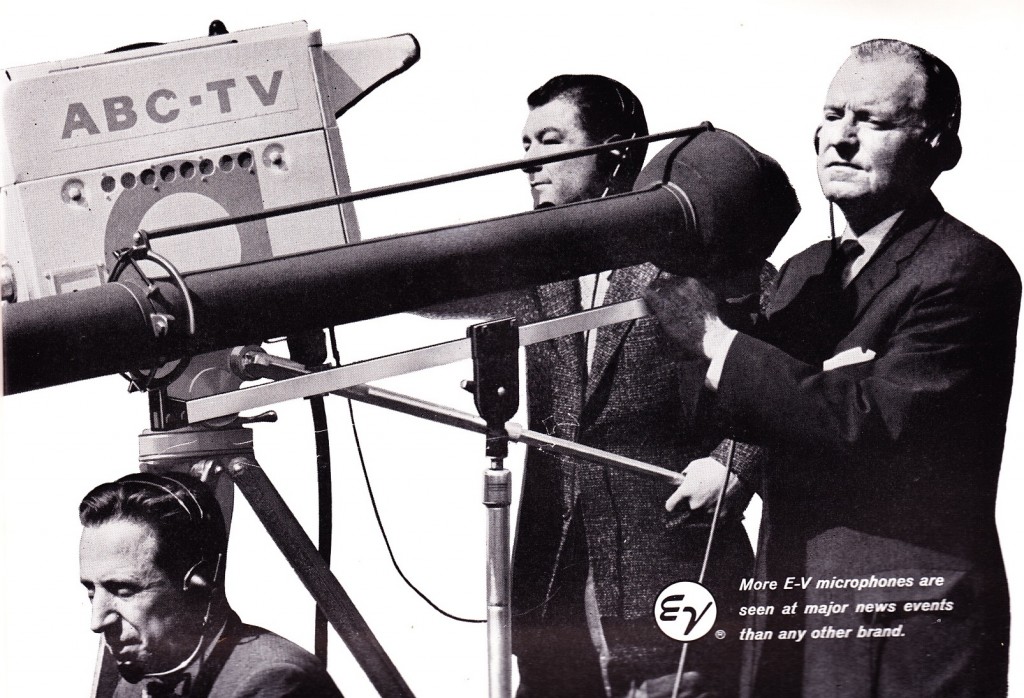 Above: the Electrovoice 643 super-directional microphone of 1961. The 643 was apparently developed by the same engineer who created the wonderful Electrovoice RE-20. Unlike the 643, the RE-20 is still in production, and still being used everyday around the world. As far as the 643…well… it was supposedly used in the 1960s for Presidential news conferences, but I can’t imagine seeing something like this aimed at a head-of-state today.
Above: the Electrovoice 643 super-directional microphone of 1961. The 643 was apparently developed by the same engineer who created the wonderful Electrovoice RE-20. Unlike the 643, the RE-20 is still in production, and still being used everyday around the world. As far as the 643…well… it was supposedly used in the 1960s for Presidential news conferences, but I can’t imagine seeing something like this aimed at a head-of-state today.
The Electrovoice Cardax Crystal Cardiod Microphone
Today we’ll look at some more microphones on offer to Radio Hams in the pages of QST Magazine circa 1947. The Electrovoice Cardax pictured above seems to have been a popular choice; this mic appears on photographs of numerous Ham radio shacks of the era. It is odd then that I have never come across one of these in all my years of digging. Are crystal mics less reliable than dynamics?
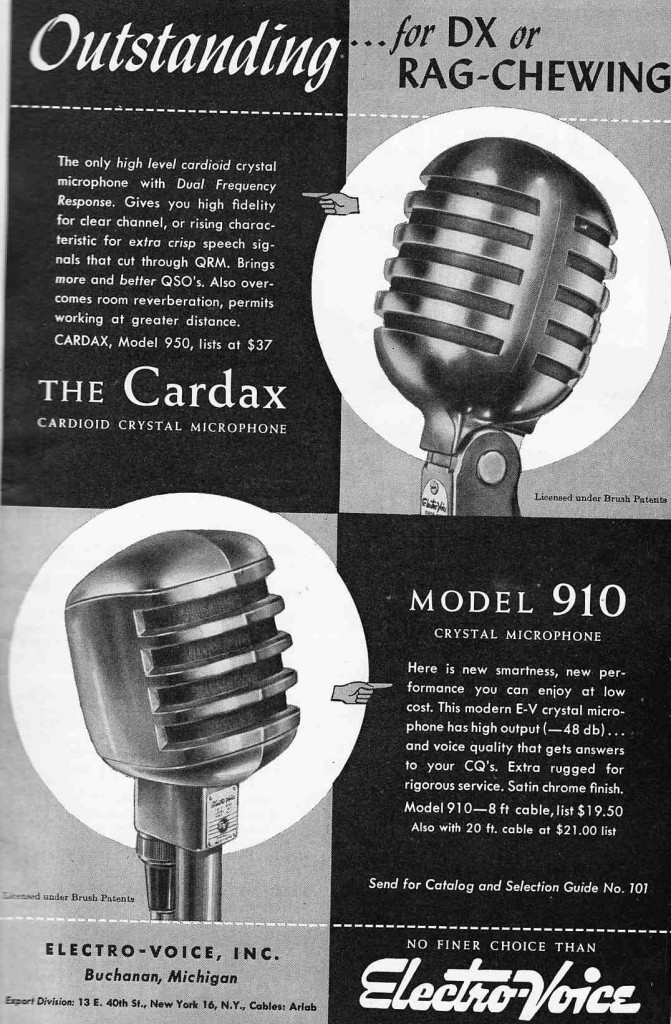 The Cardax again; also pictured is the 910, also a crystal, although presumably an omnidirectional. Half the price. Anyone using one of these?
The Cardax again; also pictured is the 910, also a crystal, although presumably an omnidirectional. Half the price. Anyone using one of these?
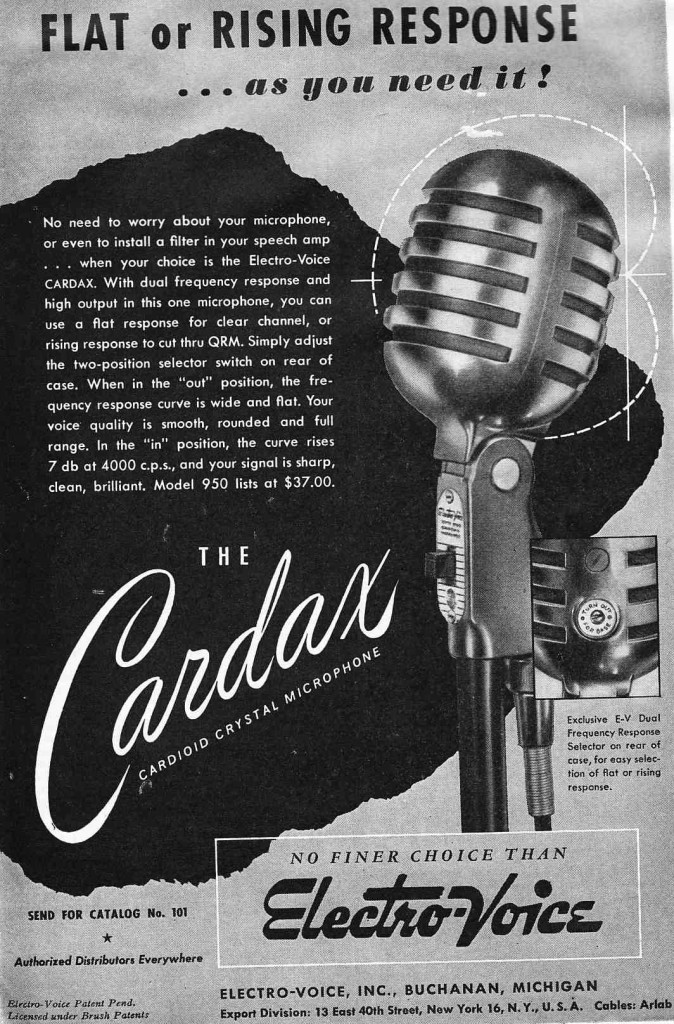 And the Cardax yet again. Here we learn that the Cardax has a presence-boost switch that adds a 7db peak at 4000 hz to add intelligibility to speech. Sennheiser notably offers this feature (well, similar enough) in their 441 cardioid dynamic. Good for use underneath a snare drum. (the 441, that is)
And the Cardax yet again. Here we learn that the Cardax has a presence-boost switch that adds a 7db peak at 4000 hz to add intelligibility to speech. Sennheiser notably offers this feature (well, similar enough) in their 441 cardioid dynamic. Good for use underneath a snare drum. (the 441, that is)
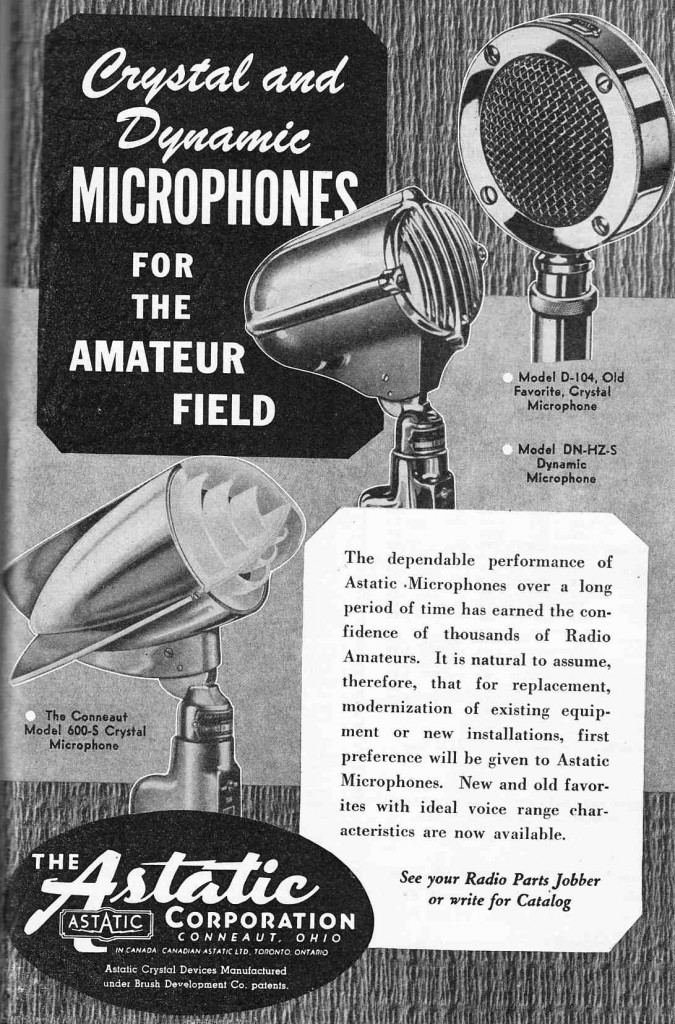
Astatic (seemingly) made microphones exclusively for the ‘communications’ (as opposed to recording or live-sound-reinforcement) market. The Astatic D-104 is the most iconic of Ham radio mics. The D-104 consists of a removable ‘head’ that attaches to a transistorized base with a push-to-talk bar. Above are a few of the ‘heads’ that mate with the D-104 base. Now that I think about it… what were these heads used with in the 1940s, prior to the introduction of the transistor?
Above is my D104 base with the working heads that I have accumulated. I’ve bought plenty of non-working ones as well. The ‘bullet’ shaped heads are dynamic and the round ones are crystal element.
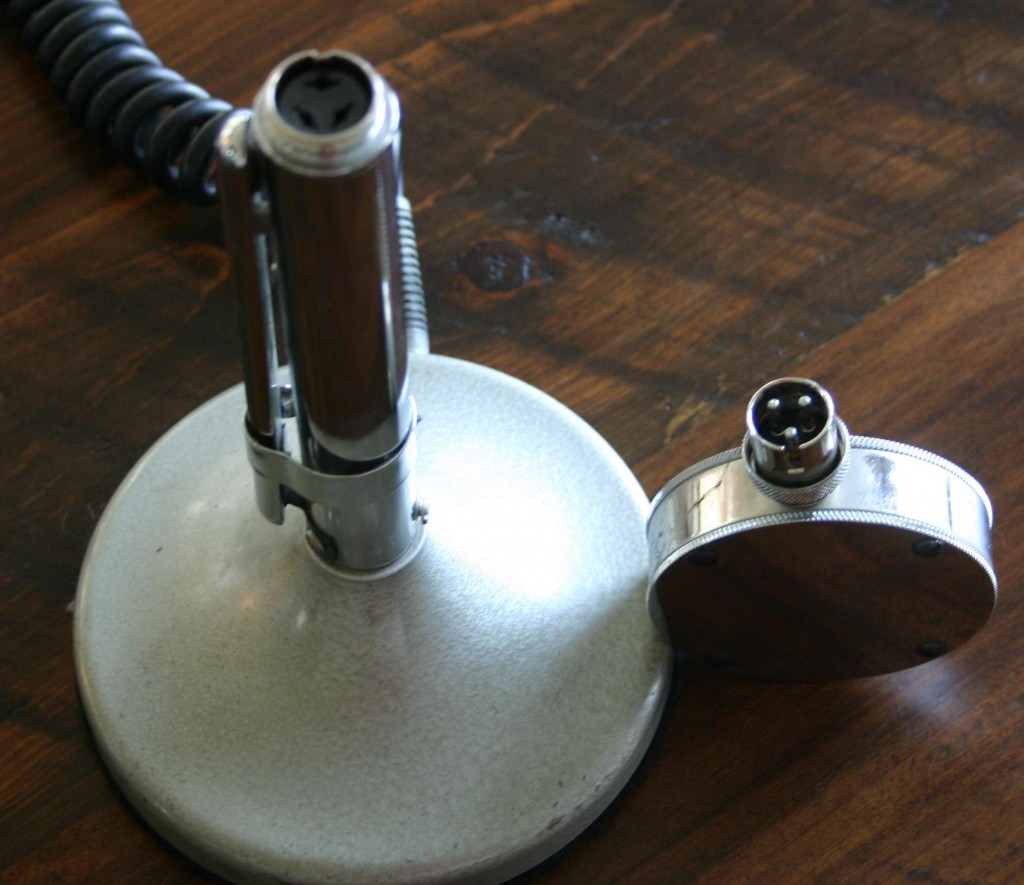 Here you can see the head removed from the base. As i said earlier, the base consists of a 9V battery-powered preamp and a large ‘push-to-talk’ bar. You will usually find these units with a 4 (or more) pin output connector designed to mate with some certain Ham radio transmitter. I modified this one to have a standard XLR-M output jack. It seems to work fine into any mic preamp. So… what can you do if you want to use these heads without the noisy, bulky base?
Here you can see the head removed from the base. As i said earlier, the base consists of a 9V battery-powered preamp and a large ‘push-to-talk’ bar. You will usually find these units with a 4 (or more) pin output connector designed to mate with some certain Ham radio transmitter. I modified this one to have a standard XLR-M output jack. It seems to work fine into any mic preamp. So… what can you do if you want to use these heads without the noisy, bulky base?
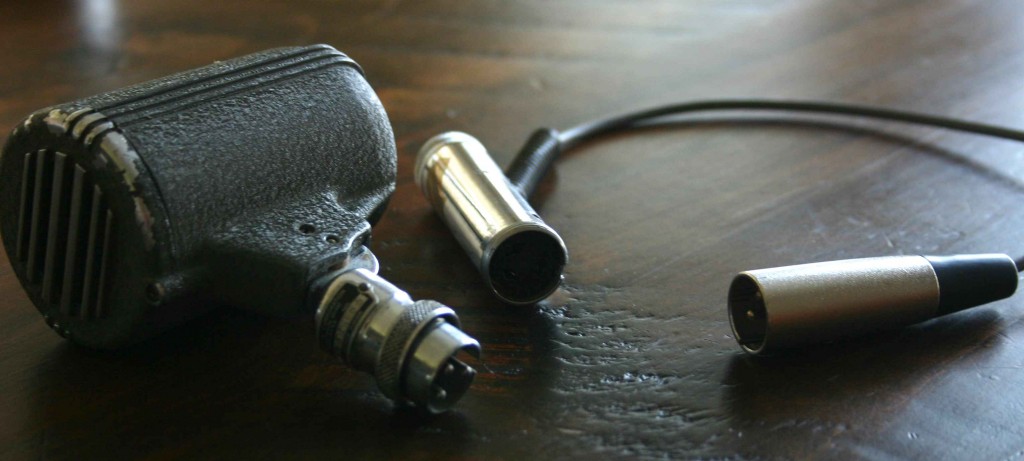 At some point I came across the 3-pin-Amphenol barrel-adaptor in the center above. Add a short length of wire and an XLR-M and voila. Seems to work fine into the mic preamps in my little Mackie test-mixer. Which I imagine has fairly high input impedance, likely 1500 ohms or more. Honestly not sure if the performance would be the same into a 150ohm or 600 ohm mic input but… point is, if you find some of these heads, yes they can be used easily without the base unit.
At some point I came across the 3-pin-Amphenol barrel-adaptor in the center above. Add a short length of wire and an XLR-M and voila. Seems to work fine into the mic preamps in my little Mackie test-mixer. Which I imagine has fairly high input impedance, likely 1500 ohms or more. Honestly not sure if the performance would be the same into a 150ohm or 600 ohm mic input but… point is, if you find some of these heads, yes they can be used easily without the base unit.
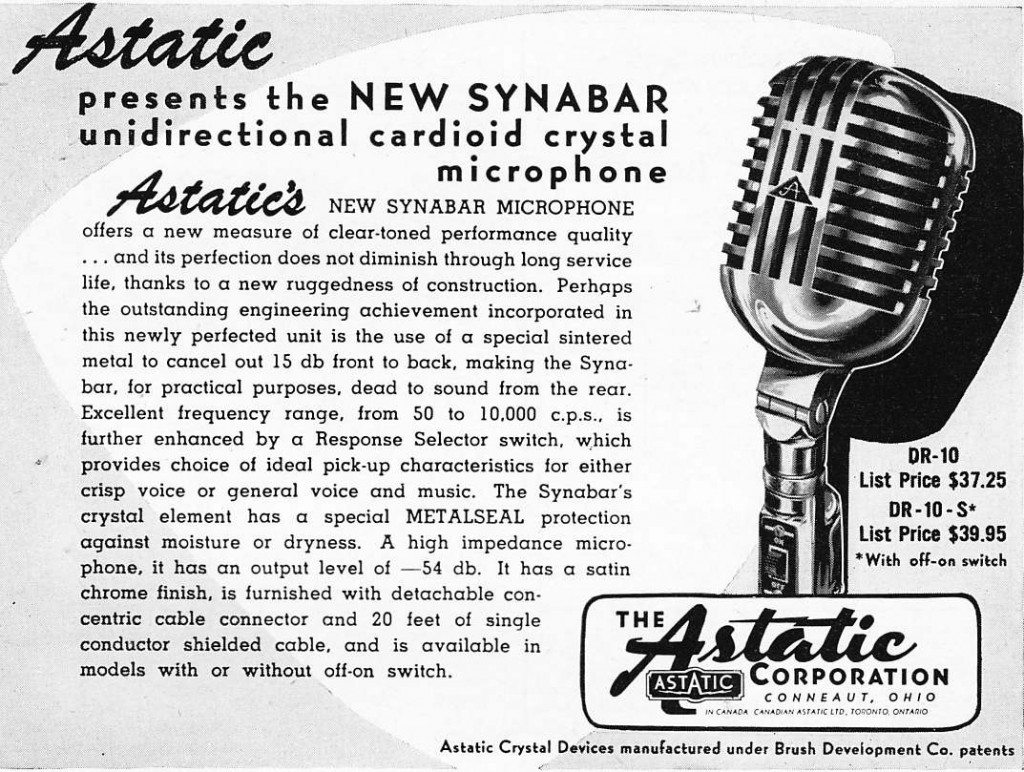 Alright back into it. Above is the Astatic Synabar. Never seen one of these. Seems to be identical to the EV cardax: same feature set, pricing, etc.
Alright back into it. Above is the Astatic Synabar. Never seen one of these. Seems to be identical to the EV cardax: same feature set, pricing, etc.
********
Above: an advert for the Shure ‘Versatex,’ a plastic-bodied crystal mic. Great design. And very rare AFAICT. To the right we have the venerable Shure “556” broadcast-dynamic mic, one of the better -quality microphones made in the 1940s. The best modern comparison would probably be the SM-7. Anyhow, the fire-damaged 556 is depicted here not to sell 556s, but as “a living testimonial to the ruggedness and dependability of all Shure Microphones.” Presumably this does not include plastic microphones such as the Versatex, which could not fare well in a firey inferno. The advert goes on add: “For Ham use, we recommend the 708A Stratoliner and the 707A Cyrstal Microhones.”
********
And there you have it. The 707 may look like the famous Shure ‘Green Bullet,’ but the element, and the sound, is completely different. The Green bullet uses a dynamic element with a property that Shure calls ‘Controlled Reluctance,’ which basically indicates a dynamic mic element that does not require an output transformer to mate with the input transformer of a mic preamp. The 707, on the other hand, is a crystal mic.
Studio Microphones of 1955
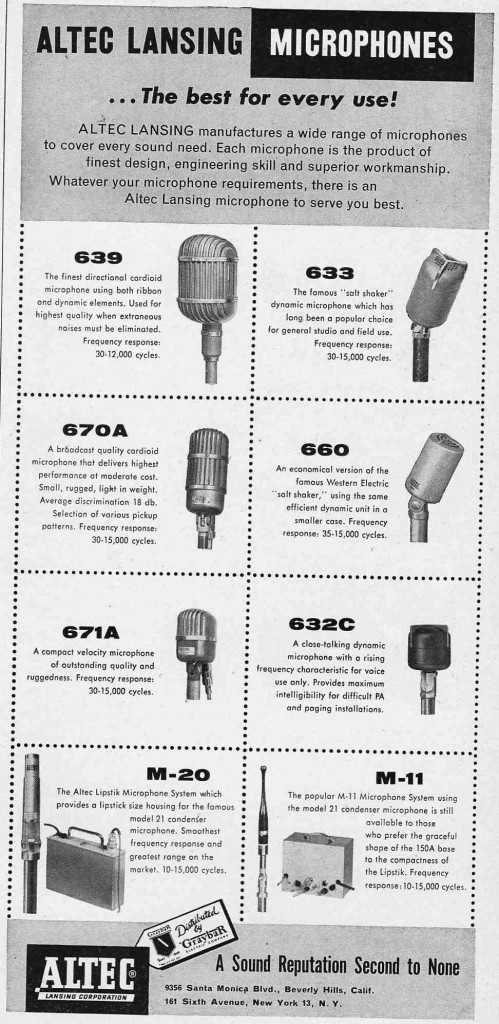 The Altec 639, 633, 670A, 660, 671A, 632C, M-20, and M-11 microphones
The Altec 639, 633, 670A, 660, 671A, 632C, M-20, and M-11 microphones
From the pages of AUDIO magazine in 1954/55: new and new-ish studio microphones at the dawn of the transistor age. Check em out…
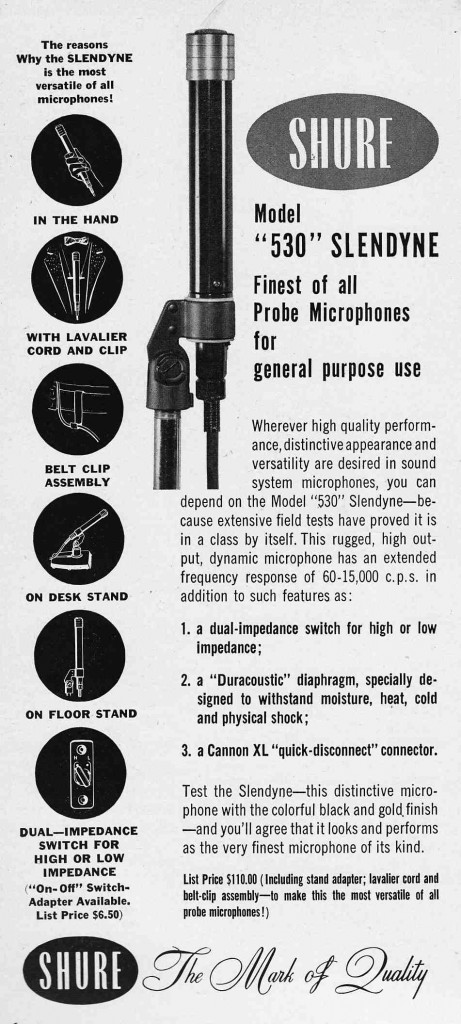 The Shure 530. This was Shure’s mid-range ‘pencil’ mic in the 1950s. At the top end was the 525; lower in the line was the 535. See this link for some audio tests including the 535.
The Shure 530. This was Shure’s mid-range ‘pencil’ mic in the 1950s. At the top end was the 525; lower in the line was the 535. See this link for some audio tests including the 535.
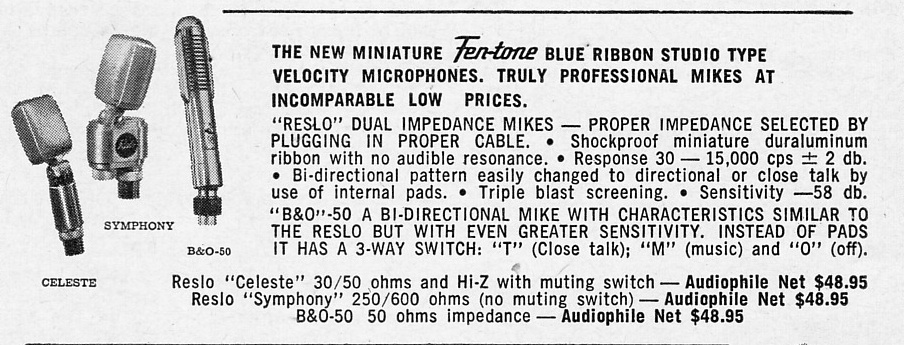 Reslo and Bang & Olufsen ribbon microphones were marketed and distributed in the USA under the ‘Fentone’ banner in the 1950s. Fentone continued as a brand-name for microphone marketing into the 1960s, but later Fentone product was not of this quality.
Reslo and Bang & Olufsen ribbon microphones were marketed and distributed in the USA under the ‘Fentone’ banner in the 1950s. Fentone continued as a brand-name for microphone marketing into the 1960s, but later Fentone product was not of this quality.
Above is the two-page advertising spread that introduced the Electrovoice 666 to the world. The 666 is the grandfather of the much-beloved Electrovoice Re20, which has been a favorite of recording and live-sound engineers for decades. Like the Sennhesier 421, the RE-20 is somewhat proof that dynamic microphone technology hasn’t really advanced much in the past three decades.
********************
Above, a 1955 advert for the 666 along with a review of the 666 from AUDIO magazine.
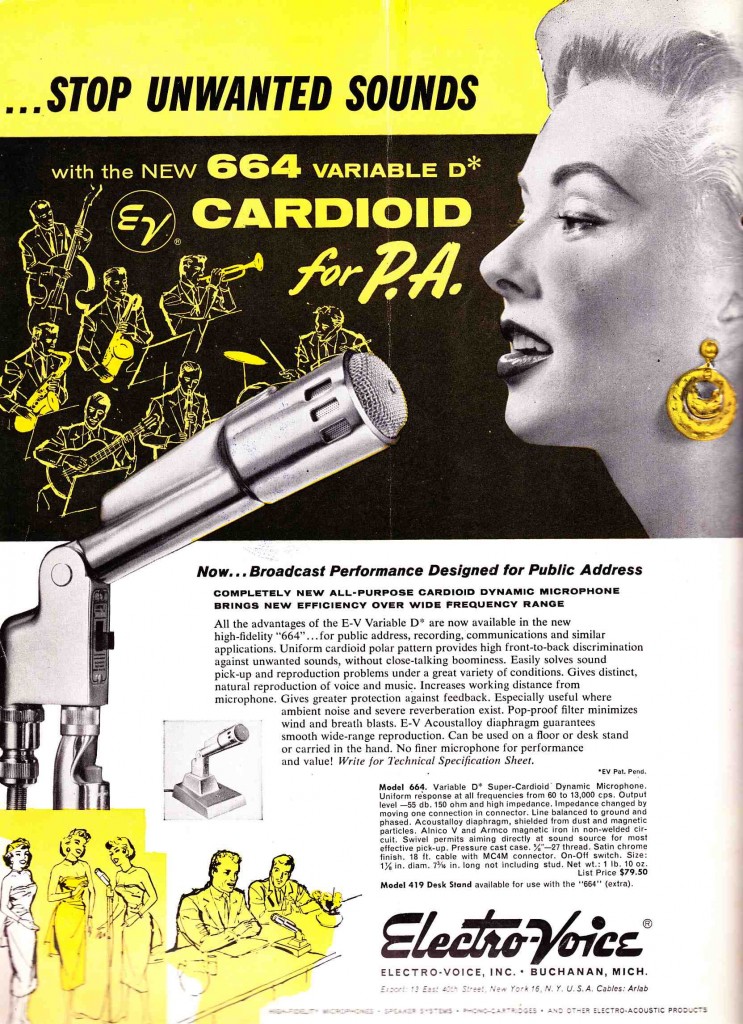 Above is a 1955 ad for the Electrovoice 664. The 664 was the ‘public address’ aka ‘cheaper’ version of the 666; the 664 was immensely popular and thousands remain today. If you come across one of these, there is a good chance it will still work fine. In terms of visual recognition, I would argue the 664 has an iconic appeal exceeded only by the Shure 55 series and the RCA 77 and 44 series. The 664 is not a terrible sounding microphone, although i don’t recommend actually using it in a modern high-decibel PA system.
Above is a 1955 ad for the Electrovoice 664. The 664 was the ‘public address’ aka ‘cheaper’ version of the 666; the 664 was immensely popular and thousands remain today. If you come across one of these, there is a good chance it will still work fine. In terms of visual recognition, I would argue the 664 has an iconic appeal exceeded only by the Shure 55 series and the RCA 77 and 44 series. The 664 is not a terrible sounding microphone, although i don’t recommend actually using it in a modern high-decibel PA system.
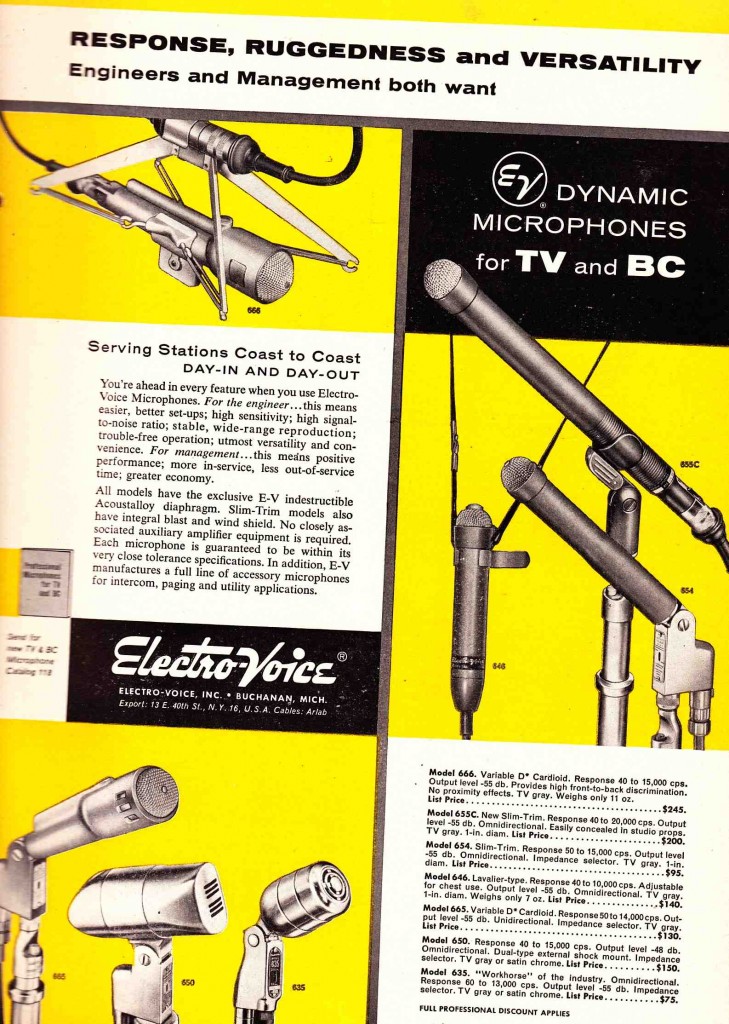 Wrapping up, here’s an ad for all the microphones that Electrovoice considered its ‘professional quality’ in 1955: the 666, lesser-variant 665, 655, its lesser variant 654, 646 lavalier, 650 and 535. Hear my pair of ancient 655s in-action here…
Wrapping up, here’s an ad for all the microphones that Electrovoice considered its ‘professional quality’ in 1955: the 666, lesser-variant 665, 655, its lesser variant 654, 646 lavalier, 650 and 535. Hear my pair of ancient 655s in-action here…
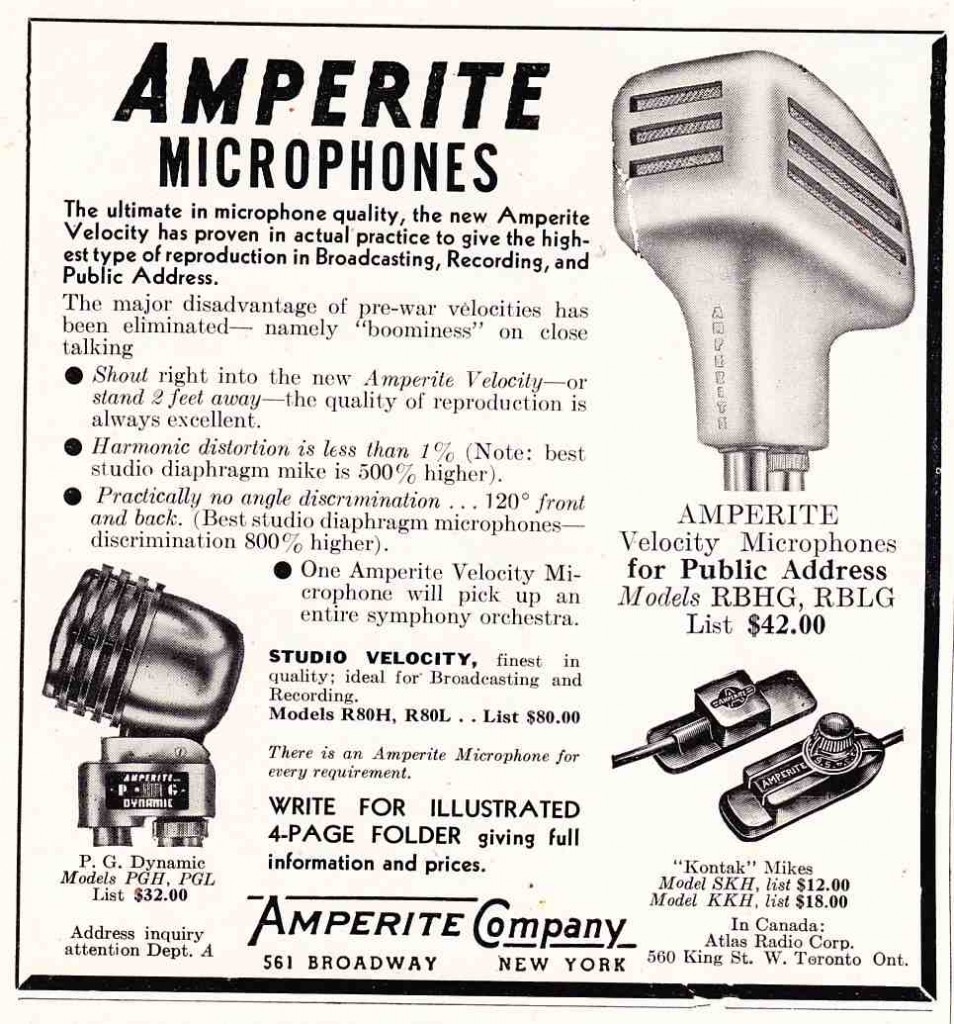 The Amperite Velocity Microphone
The Amperite Velocity Microphone
Continuing our review of Audio Engineering Magazine, today we will look at some of new offerings in microphones available to audio engineers in the late 1940s.
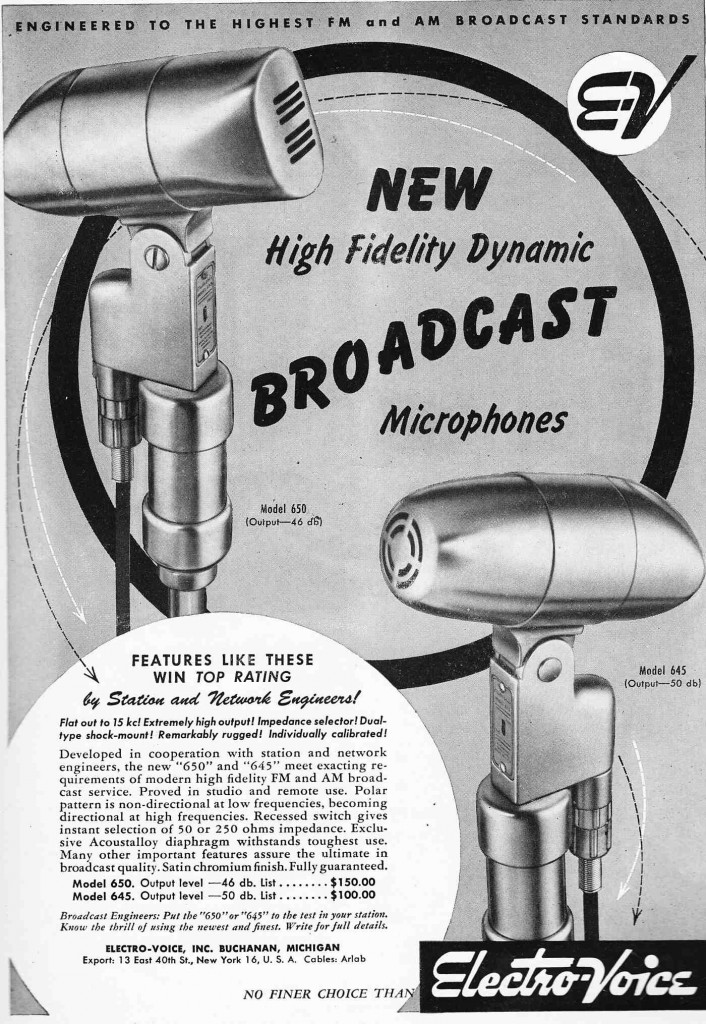 The Electrovoice 650 and 645. I really would like a nice 650… the ‘Jac Holzman Mic’
The Electrovoice 650 and 645. I really would like a nice 650… the ‘Jac Holzman Mic’
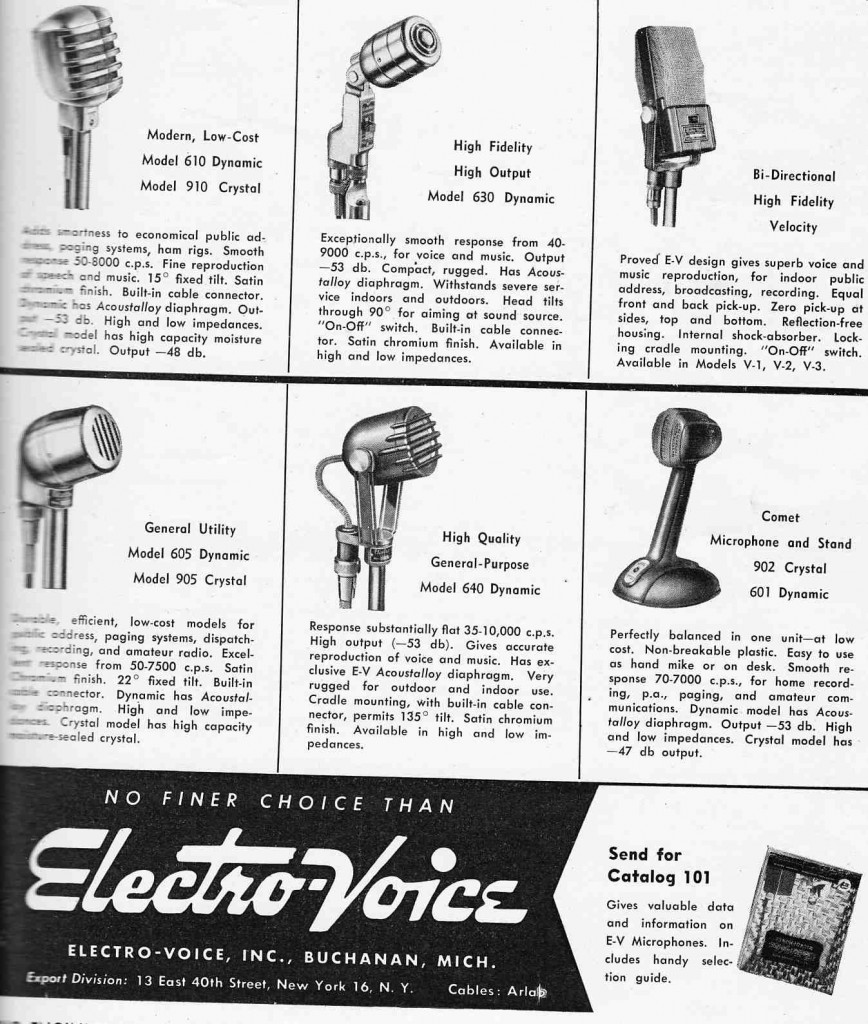 An Electrovoice line-up circa ’47
An Electrovoice line-up circa ’47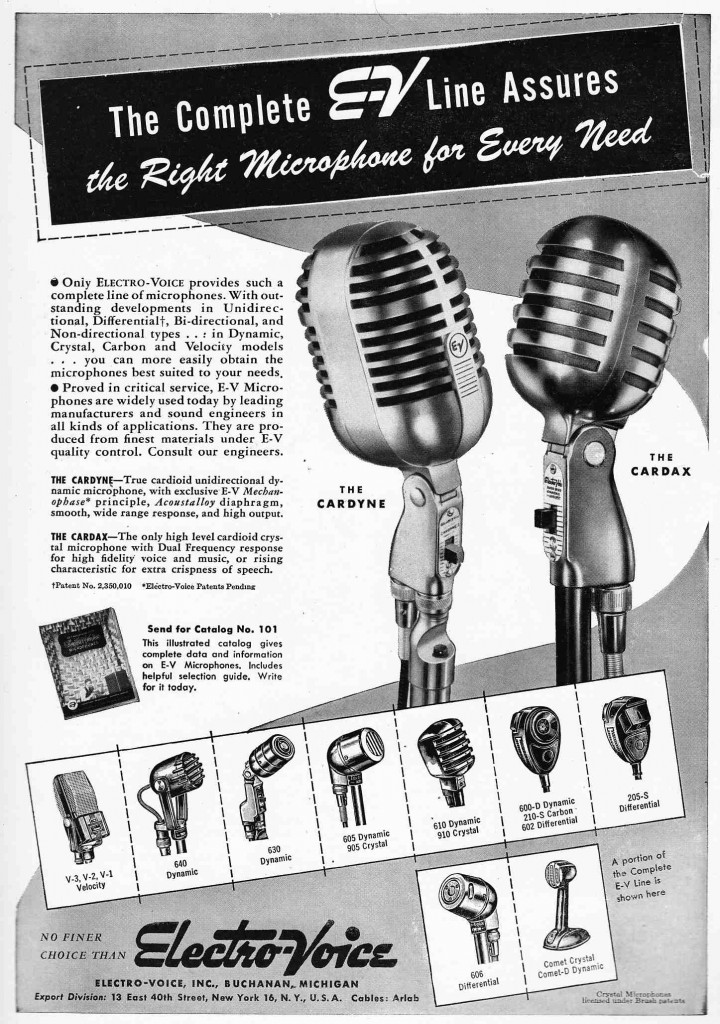 The Electrovoice Cardyne and Cardax
The Electrovoice Cardyne and Cardax
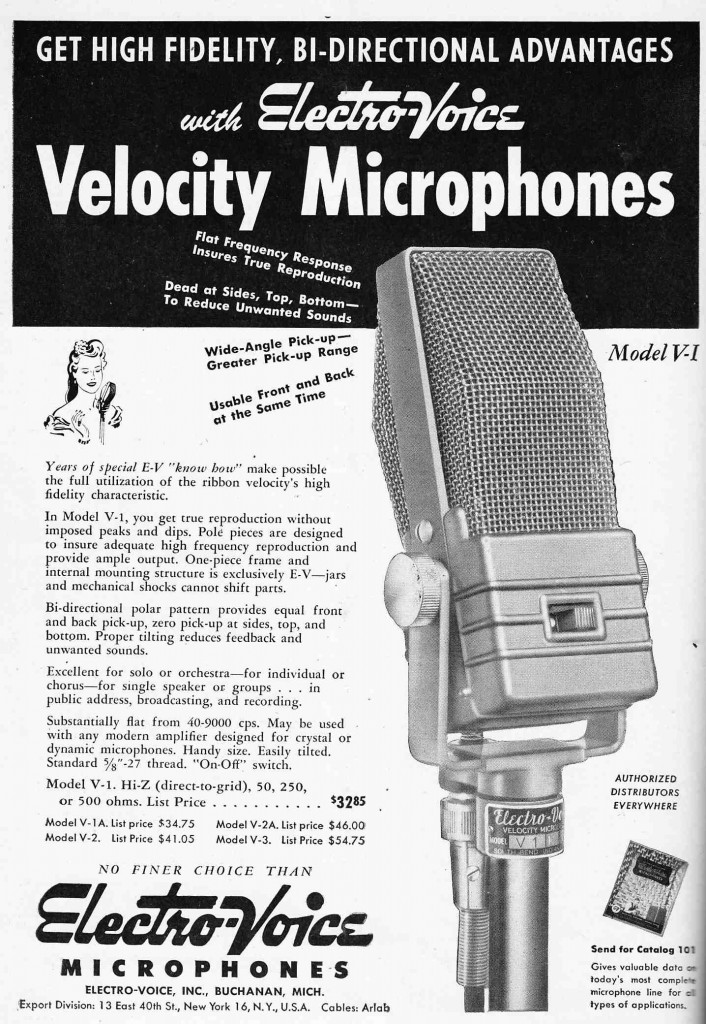 The Electrovoice V1 ribbon mic.
The Electrovoice V1 ribbon mic.
Many more images follow. Click the link below to Read-On…
Oddball dynamic mics of olden days
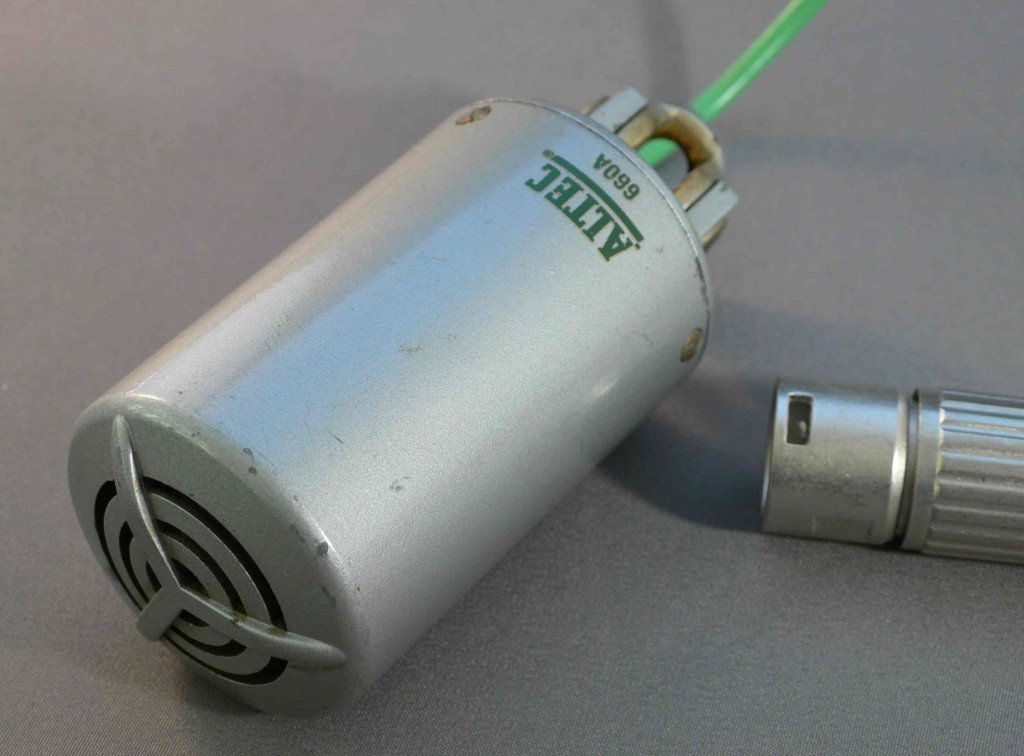 A quick review of some odd mics from the ‘pile’ that have not made it over to the studio yet. If anyone out there is using these for makin’ records, drop a line a let us know yr thoughts. Above is the Altec 660A, which is an Altec-branded iteration of an earlier western-electric mic. This thing sounds very thin. it’s quite small – check the XLR connector for size reference.
A quick review of some odd mics from the ‘pile’ that have not made it over to the studio yet. If anyone out there is using these for makin’ records, drop a line a let us know yr thoughts. Above is the Altec 660A, which is an Altec-branded iteration of an earlier western-electric mic. This thing sounds very thin. it’s quite small – check the XLR connector for size reference.
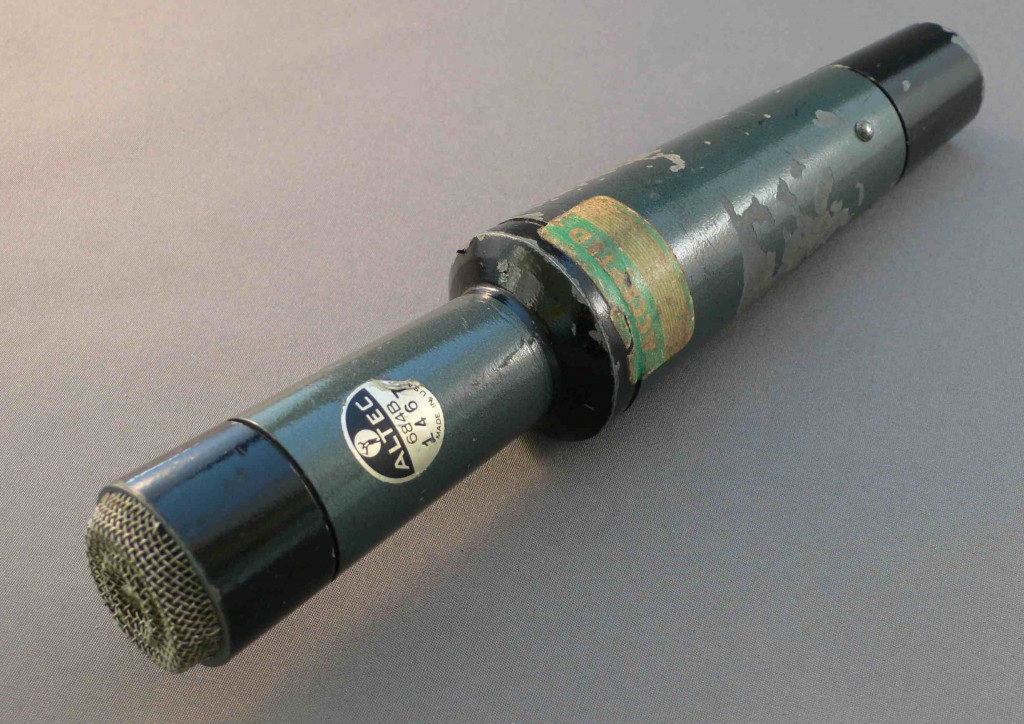 Another ancient Altec mic. this is a 684B. This piece does not sound bad, but… it failed the SM57 test. What, you ask, is the SM57 test? Well… whenever a new mic appears, i quickly A/B it with an SM57. If the SM57 sounds both ‘better’ (IE more ‘hi-fi’) AND ‘more interesting’ (this is harder to quantify….), then the new mic goes in a box somewhere. 684B up there failed the SM57 test.
Another ancient Altec mic. this is a 684B. This piece does not sound bad, but… it failed the SM57 test. What, you ask, is the SM57 test? Well… whenever a new mic appears, i quickly A/B it with an SM57. If the SM57 sounds both ‘better’ (IE more ‘hi-fi’) AND ‘more interesting’ (this is harder to quantify….), then the new mic goes in a box somewhere. 684B up there failed the SM57 test.
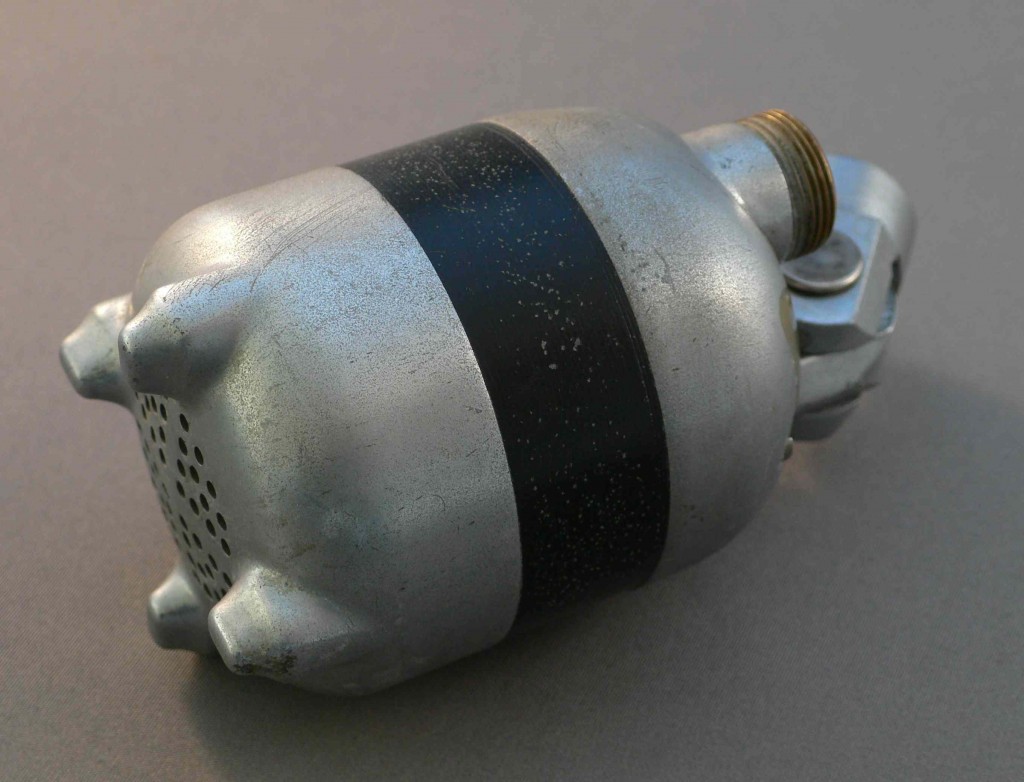 This is an American D4T. This is a hi-Z dynamic public-address mic from the 40s. This is, btw, the first antique mic i ever bought. picked this up at an antique shop in Prov RI back in the mid 90s, along with a little tube suitcase PA system and nice old cast-base mic stand… $75 i think…. This mic still works, and it sounds cool, but it’s just too distorted… feel like it sounds too ‘Pop,’ of all things, at this moment; ‘distressed-vocals’ being the trendy thing that they are.
This is an American D4T. This is a hi-Z dynamic public-address mic from the 40s. This is, btw, the first antique mic i ever bought. picked this up at an antique shop in Prov RI back in the mid 90s, along with a little tube suitcase PA system and nice old cast-base mic stand… $75 i think…. This mic still works, and it sounds cool, but it’s just too distorted… feel like it sounds too ‘Pop,’ of all things, at this moment; ‘distressed-vocals’ being the trendy thing that they are.
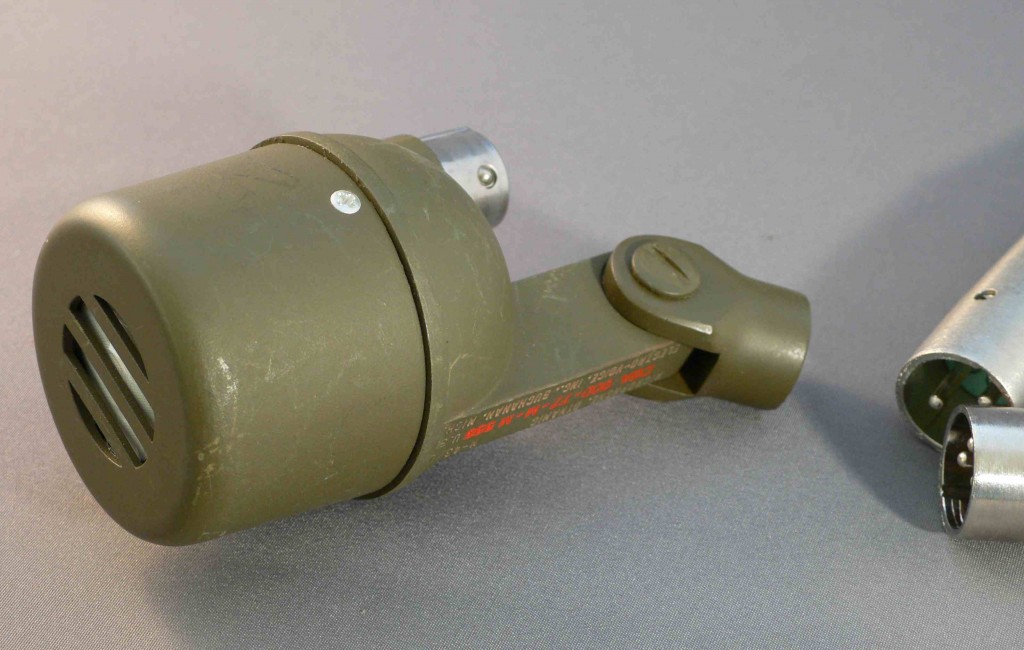 An Electro-voice military communications mic. Got this one still in its heremetically-sealed, foil-lined pouch. It ain’t bad, but… i have too many mics like this, only just slightly better….
An Electro-voice military communications mic. Got this one still in its heremetically-sealed, foil-lined pouch. It ain’t bad, but… i have too many mics like this, only just slightly better….
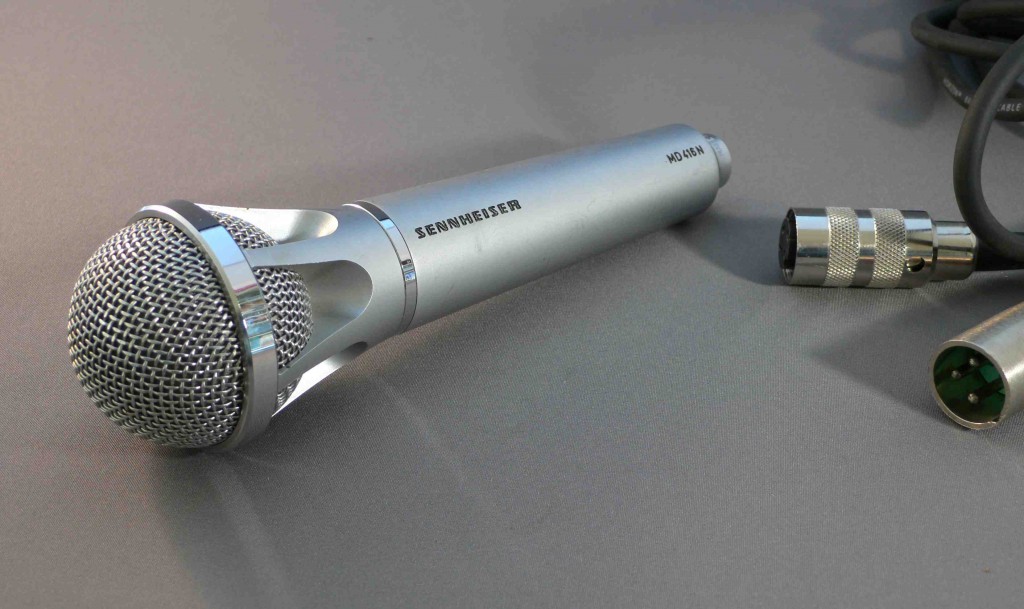 A Sennheiser MD 416. I was really excited about this thing, and i paid like $100 for it, which is a fortune for a cheapskate like me. Now, I have a lot of old sennhesiers… an original 409, 421, and several 441s… and i really dig them… but this thing just has no… balls? No low-end, at least. And that Mini-Tuchel-to-XLR cable wasn’t cheap either. This gets my vote for the most-expensive-mic-that-looks-like-a-really-cheap-mic. I will call it Paris H. from now on.
A Sennheiser MD 416. I was really excited about this thing, and i paid like $100 for it, which is a fortune for a cheapskate like me. Now, I have a lot of old sennhesiers… an original 409, 421, and several 441s… and i really dig them… but this thing just has no… balls? No low-end, at least. And that Mini-Tuchel-to-XLR cable wasn’t cheap either. This gets my vote for the most-expensive-mic-that-looks-like-a-really-cheap-mic. I will call it Paris H. from now on.
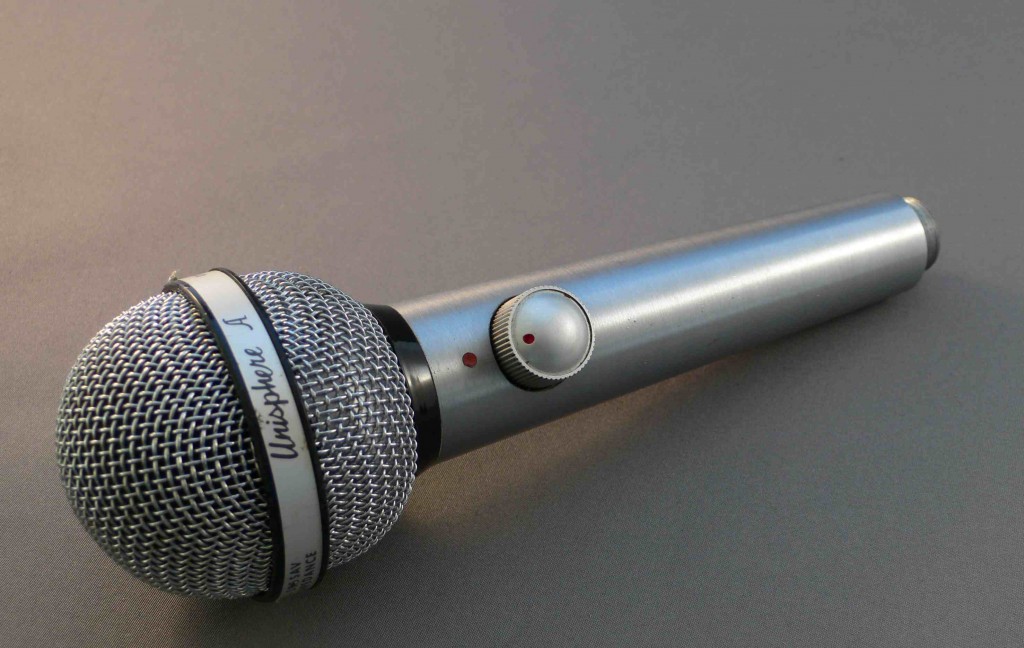 Shure 585 ‘unisphere A.’ Basically a cheap hi-z dynamic with a volume pot built in. I think this is known as the ‘James Cotton’ mic. Cotton was a harmonica player in the 60s whi apparently used just about every amp and mic in existence at one point or another, cos there is really no limit to the range of items people are eager to associate with him.
Shure 585 ‘unisphere A.’ Basically a cheap hi-z dynamic with a volume pot built in. I think this is known as the ‘James Cotton’ mic. Cotton was a harmonica player in the 60s whi apparently used just about every amp and mic in existence at one point or another, cos there is really no limit to the range of items people are eager to associate with him.
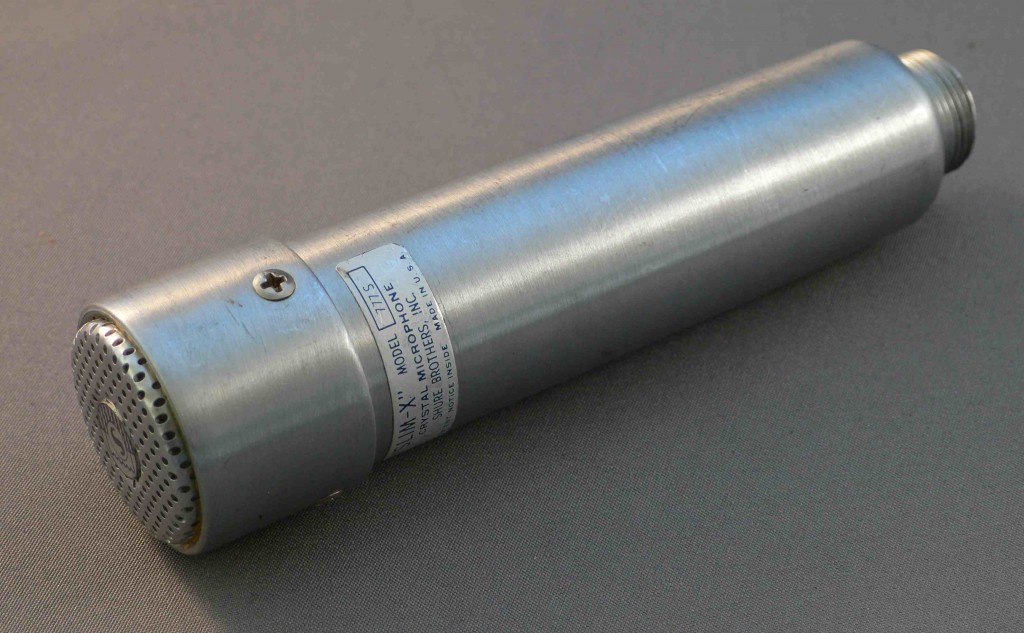 Shure 777s Crystal mic with switch. I think this came with a large pile of old mics. It’s a 60 year-old crystal mic. not much more to say.
Shure 777s Crystal mic with switch. I think this came with a large pile of old mics. It’s a 60 year-old crystal mic. not much more to say.
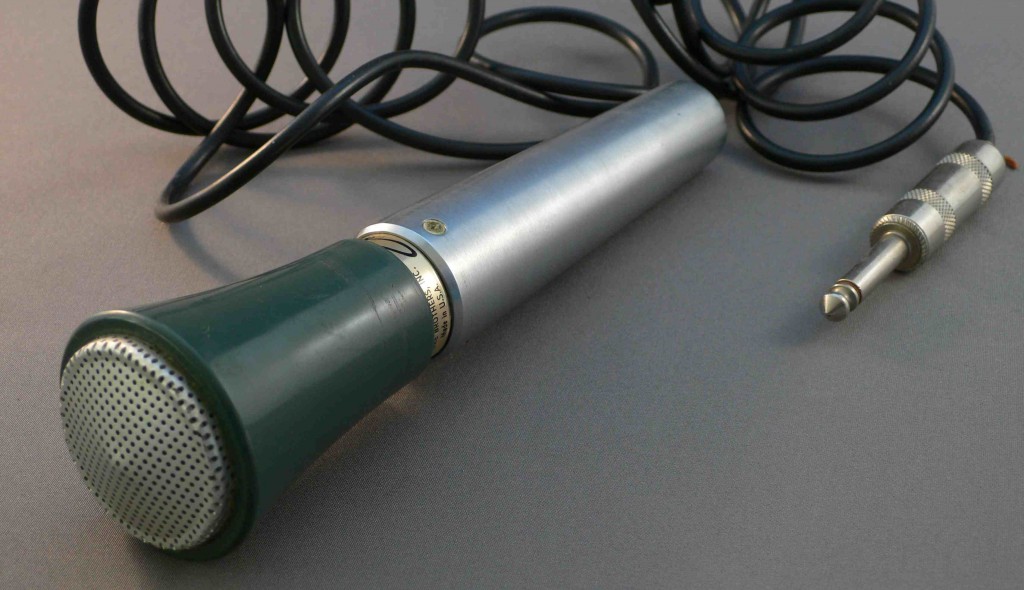 Shure Commando. Honestly not even sure what kind of mic this is. Sounds pretty cool but it’s hi-z so it’s a pain in the ass to use in the studio. harp (harmonica) dudes seem to dig these.
Shure Commando. Honestly not even sure what kind of mic this is. Sounds pretty cool but it’s hi-z so it’s a pain in the ass to use in the studio. harp (harmonica) dudes seem to dig these.
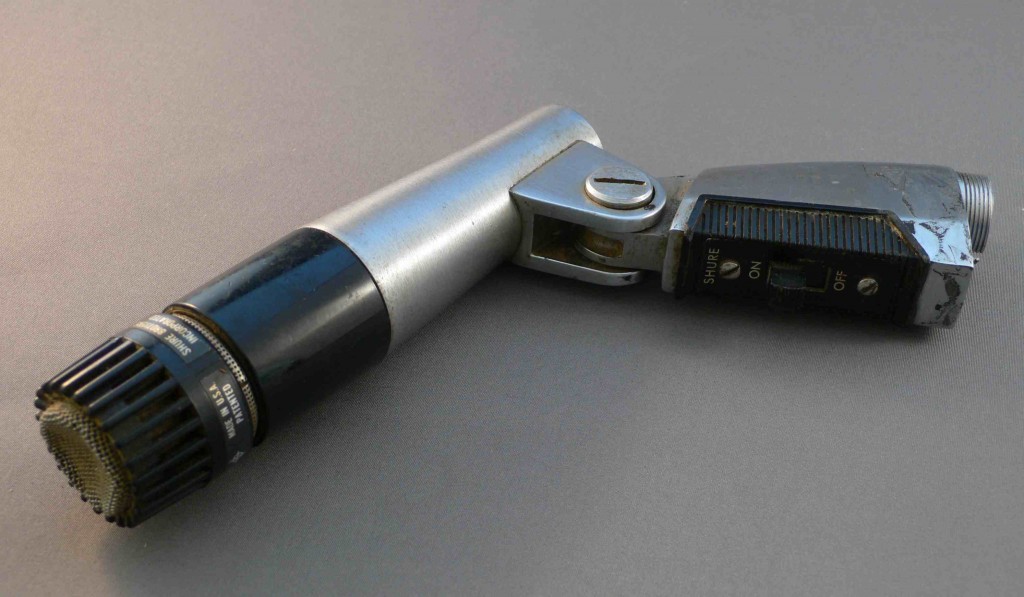 Shure PE-54. The ‘PE’ stands for ‘Professional Entertainer,’ believe-it-or-not (seriously, though, this is true.). This is the hi-z version of the Unidyne III… which is the forerunner of the SM57. This is actually a really good sounding mic, but since it’s hi-z, it’s a pain to use. I have an SM56, which is the balanced version of this thing, so this is kinda redundant. but for real this mic sounds great. i was surprised.
Shure PE-54. The ‘PE’ stands for ‘Professional Entertainer,’ believe-it-or-not (seriously, though, this is true.). This is the hi-z version of the Unidyne III… which is the forerunner of the SM57. This is actually a really good sounding mic, but since it’s hi-z, it’s a pain to use. I have an SM56, which is the balanced version of this thing, so this is kinda redundant. but for real this mic sounds great. i was surprised.
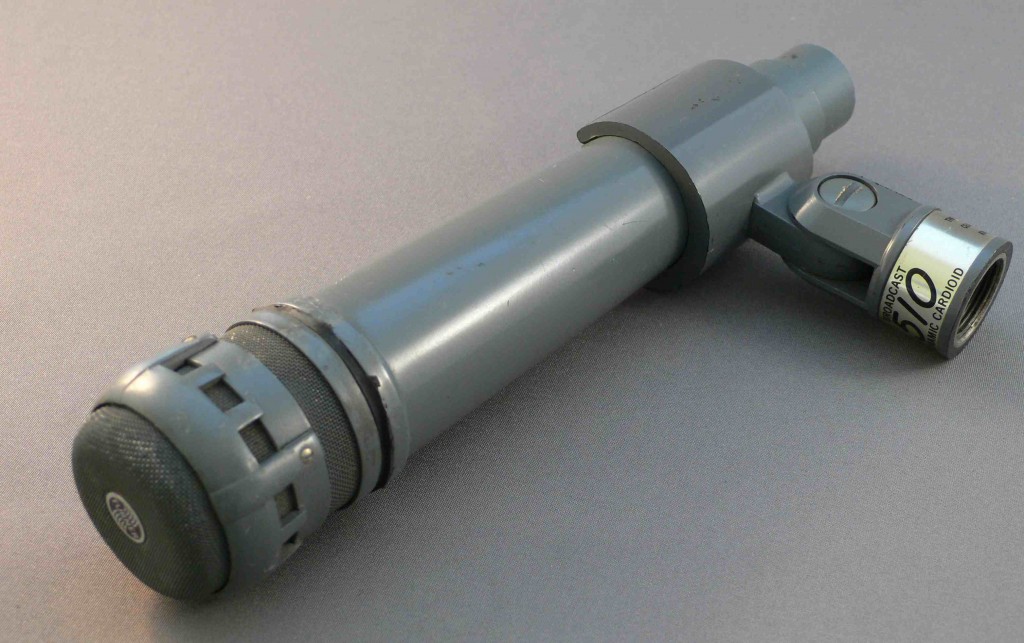 Turner 510. The best dynamic mic Turner ever made. I am actually not sure how this thing failed the SM57 test. Think maybe it deserves another chance. Look for a shoot-out including this mic. here. soon.
Turner 510. The best dynamic mic Turner ever made. I am actually not sure how this thing failed the SM57 test. Think maybe it deserves another chance. Look for a shoot-out including this mic. here. soon.
